Deepen your insights
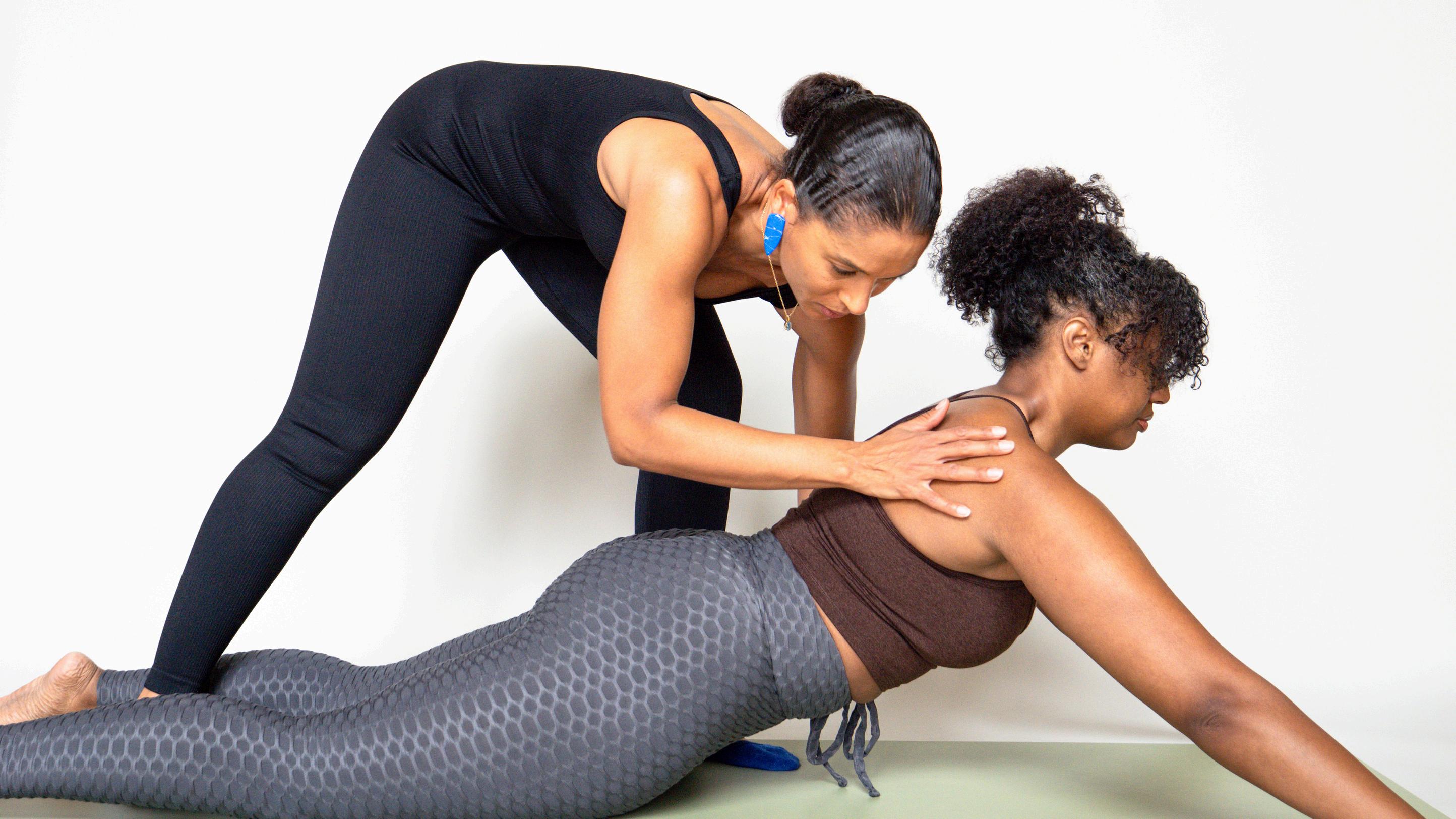
TRAINING ATHLETES VS. SENIORS
Learn
I S S U E 1 7J U N E 2 0 2 4 A JOURNAL WHERE PILATES PROFESSIONALS COME TOGETHER TO LEARN, DISCOVER AND SHARE IN THE JOY OF MOVEMENT
how we can challenge both sets of clients for the better
CREATING A STUDIO WITH HEART
studio that’s warm at heart S S N 2 9 8 20 4 3 X
Developing a
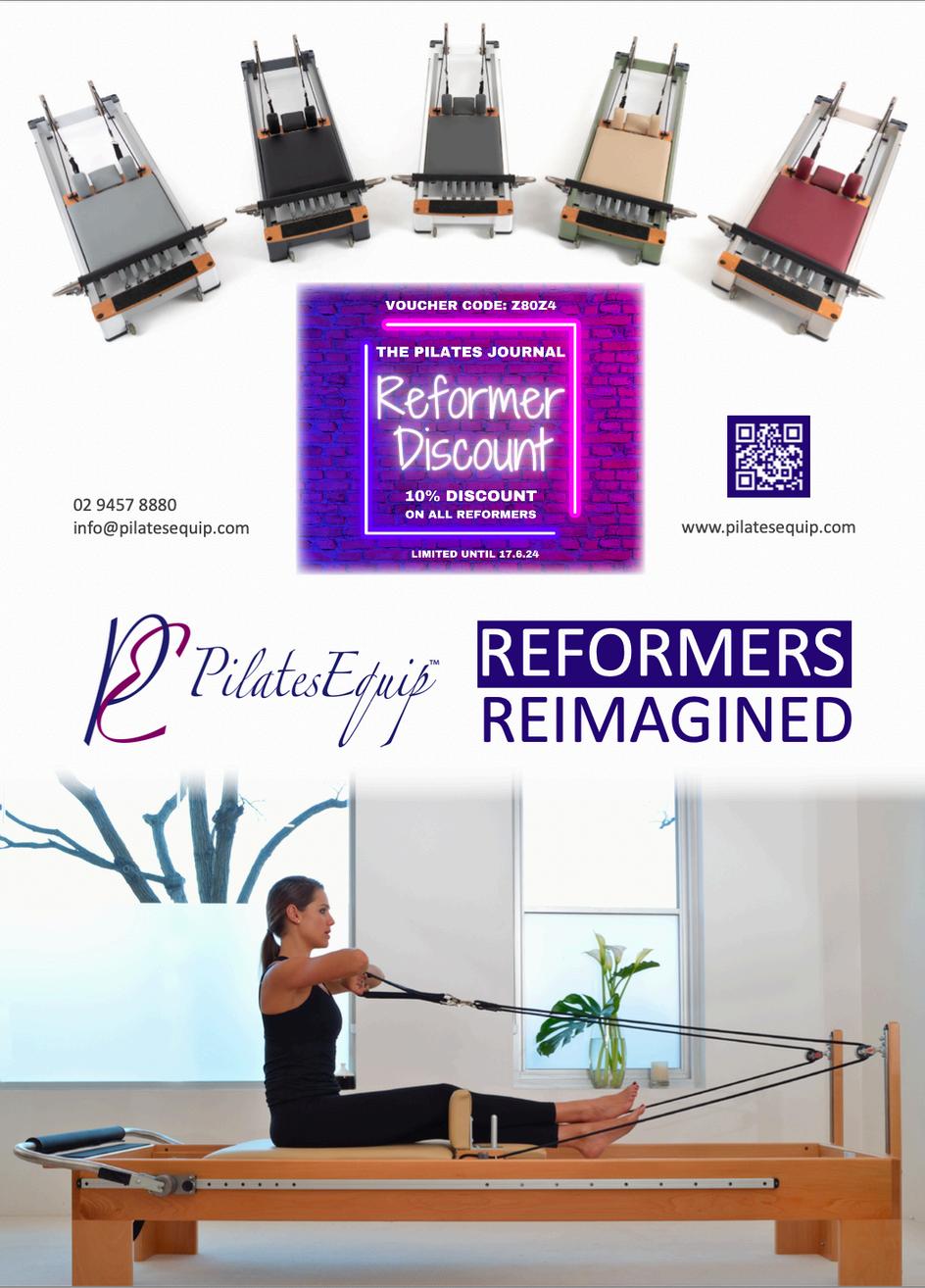
5
EDITOR’S NOTE
Welcome to another edition of the Pilates Journal
8
CREATINGASTUDIOWITH HEART
What sort of community are you developing at your Studio? Is it warm at the heart? 10
INTEGRATINGTHEDEEP FRONTLINE
Understand the transformative power of utilising the bodywide myofascial core for greater somatic integrity
13
18 14
SAM’SVIEW
Each month BASI Pilates Practitioner and Physio Samatha Wood will share the latest research in the Pilates industry

TRAININGATHLETESVS. SENIORS
We discuss how you keep up the challenge for both athletes and seniors
HOWDOYOUKEEPYOUR TEAMMOTIVATED?
Ensure you have the industry standard in equipment
Growing your business means growing your team’s skill set 23
Discover the next evolution of Pilates with
Photography @noosaflow
The Pilates Journal would like to acknowledge and pay respects to the Gadigal people of the EORA nation as the traditional custodians of the place we call homeSydney - where this journal is produced
The Pilates Journal pays respects to their elders, past, present and emerging, and acknowledges all Aboriginal and Torres Strait Islander peoples
ISSUE 17 PILATESJOURNAL COM 3 Contents
21 FLEXIA:TRANSFORMING PILATESWITHTECHNOLOGY
datadriven performance metrics
ELEVATINGPILATES STANDARDS
26
LEAVINGTHELUNGESBEHIND BUTNOTYOURGLUTES
Learn how to get optimal glute activation without ever having to teach your clients a lunge
29
32
TURNINGOUTSOCCERPLAYERS
Soccer players are seeing more knee injuries, and Pilates practitioners can help by integrating body alignment and movement exercises to reduce injuries
WHYWESHOULDN’TKEEP DRAWING-INTHEABDOMINALWALL
Read why the “abdominal drawing-in”cue may not be that beneficial as once thought
36
INSTRUCTORSPOTLIGHT: ANDREAJOBBAGY
We speak with Pilates Instructor Andrea Jobbagy about her Pilates career to date and her teaching focus


4 Contents ISSUE 17 PILATESJOURNAL COM
Photography @seaswell
Note from the Editor

Welcome to the latest issue of The Pilates Journal.
For our June edition, we celebrate the transformative nature of Pilates, with studios becoming sanctuaries and vibrant communities thriving We begin with a heartwarming interview featuring South African Pilates professional, Tash Barnard, who shares her journey of creating a compassionate studio environment
Our exploration of movement science continues with Founder of art of motion Academy Karin Gurtner, exploring how it can enhance client experiences Additionally, US pilates instructor Nicky Lal provides guidance on tailoring Pilates sessions for athletes and seniors, highlighting the nuanced approaches required
For studio owners, we discuss cultivating positive work environments to ensure staff and clients thrive and what your own self development could look like
We also look to the future with Flexia Pilates and discuss how our Pilates equipment needs to keep pace with AI and other datadriven assessments of wellness practices and how this can benefit teachers
CONTRIBUTORS
Tash Barnard, Karin Gurtner, Nicky Lal, Alisha Porter, Kira-Leigh Rule, Heidi Wright, Chris Skinner, Shannon Leggett and Julio Cesar Aragón Salamanca.
CONTACT US
Editorial
Editor-in-Chief
Cie’Jai Zarb hello@pilatesjournal com
Photography
Tash Barnard, Karin Gurtner, Nicky Lal, Alisha Porter, Kira-Leigh Rule, Noosa Flow, Heidi Wright, HF Industries, Alexa Idama and Julio Cesar Aragón Salamanca
Advertising Cie’Jai Zarb 61412209460
PO BOX 2193 Clovelly West NSW 2031 hello@pilatesjournal com
Questions/Feedback
If you would like to contribute or have any questions, please contact us at hello@pilatesjournal com
On the Cover
Alexa Idama and student
ISSUE 17 PILATESJOURNAL COM
CJZarb FOUNDER AND EDITOR-IN-CHIEF
5

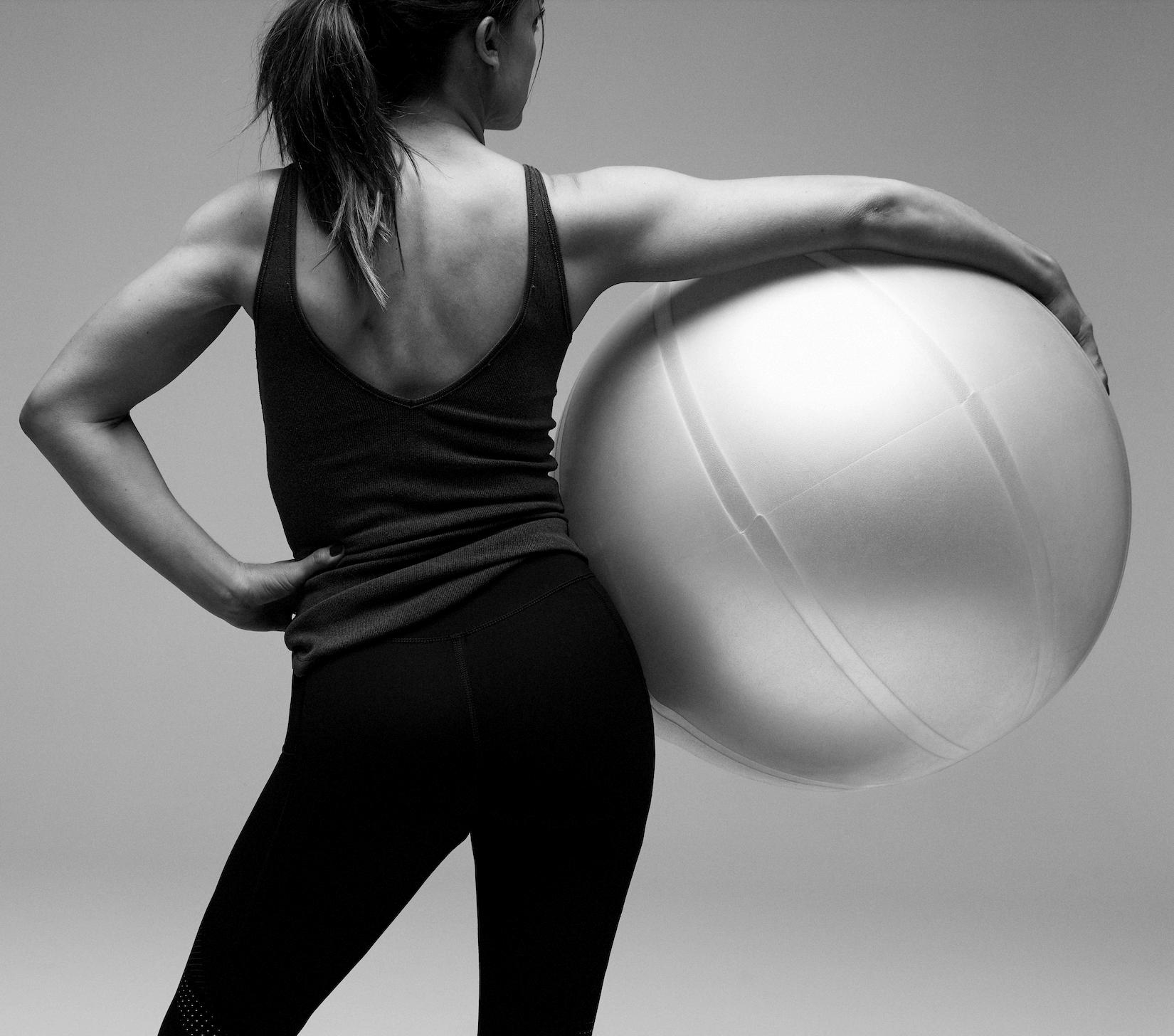
3 + 4 AUGUST 2024
BONDI, SYDNEY








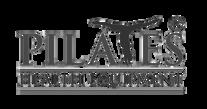










PILATESJOURNALEXPO.COM Join us for a 2-Day Workshop Learn from Industry Leaders Further Your Skills Networking Drinks Expo Showcase and more! Book now and save using the PROMO CODE: EXPOEARLYBIRD24 INDUSTRY PARTNERS SUPPORTERS OUR PARTNERS
Creating a studio with HEART
WHAT SORT OF COMMUNITY ARE YOU DEVELOPING AT YOUR STUDIO? IS IT WARM AT THE HEART?
by CJ Zarb
When you step into a Pilates studio, what do you feel? Is it merely a place to exercise, or is it a warm, welcoming community that embraces you like family? Tash Barnard, the passionate BASI Pilates instructor behind South Africa's TashB Studio, has masterfully crafted a studio that resonates with warmth and heart
Tash is honored to say that she was trained and certified by Master trainer Rael Isacowitz in 2001 She began her journey as a BASI teacher in 2000, fueled by a passion not only for Pilates but also for people and community "It's always been about community over competition," she affirms with a warm smile. Located inside her church, Linc church, alongside a CrossFit gym and Wonderland coffee shop, TashB Studio in South Africa radiates a sense of belonging and unity
"Early in my Pilates career, I was inspired by my first Pilates teacher Kristi Cooper and Studio Owner Annmaree Munk who I worked for in Hong Kong Then in 2007 I created my own studio and soon after fell pregnant," Tash reflects. “Falling pregnant so soon made me realise that I was born for something greater than myself and that my purpose was bigger than I had originally thought I had a vision to set a high standard of excellence in the Pilates industry in South Africa. My studio was the first Pilates studio in Ballito, where we live which is affectionately known as

the "promised land" among locals I designed my studio to become a beacon of quality and continuity in South Africa,” said Tash. Over the years many Pilates instructors in the area have been BASI trained and mentored by Tash herself and have been influenced by her unique approach to teaching With a dedicated team of six BASI-trained instructors, Tash's studio prioritises quality over quantity in her teaching team, ensuring clients always receive exceptional care and attention “I always get such a heartwarming feeling when a client finally realises that they are enough, that they accept and love and trust their bodies It fuels me to do more of what I love,” said Tash.
"We are all about continuity of care," Tash affirms Weekly team meetings foster a strong sense of connection and collaboration, celebrating client breakthroughs and aligning on collective goals. "We focus on showing up over profit," she adds, reflecting her philosophy of people over profit

This ethos extends beyond the studio walls through various outreach projects that Tash and her team passionately support "Buckets of Hope" provides non-perishable food to combat poverty in the community, while "The Red Movement" offers essential support to women in need during their menstrual period by providing education and menstrual cups for women who don’t
8
ISSUE 17 PILATESJOURNAL COM COMMUNITY
have access to sanitary products Additiona recently helped a friend of Tash’s in rebuild loss of her husband, so she could continue on women’s health All this highlights the p Tash's commitment to her community
Tash adapted during COVID by offering on sessions, which to this day still attracts part the globe "People from the Netherlands, w in person, continuously show up," she marv extends to her teaching the BASI method in South Korea, Turkey, London, Singapore, a uniting people from diverse backgrounds u
Despite language barriers during internatio remains undeterred, focusing on delivering the BASI method "It's about helping them r embarked on this journey in the first place, Tash's humility shines through when she ac collective effort that has shaped her studio about me, it's about our entire community," the unwavering support of her husband an Tash emphasises the importance of open c mutual respect within her community During challenging times, such as the rece that affected their community, Tash and he their unwavering commitment to serving ot together – we rally for our people," Tash as they supported affected baristas by deliver the crisis.


options when cueing setup (including wing for adjustments to “standard” and progression, and allowing the t for them in the moment. And if they ody forgets the time they tried to doAs your friends, and I'll show you your y is a testament to the power of d perseverance and how Pilates was h her dedication to Pilates and people, d vibrant context of South Africa, Tash ift her community, proving that true rs with honour and respect.
e is one thing, creating a family and ugh Pilates is another and Tash exudes . And her Pilates practice benefits
e pilates instructor and business for Pilates in 2000 through BASI As aculty member for BASI, she teaches bassador of this pure pilates form. celebrates 17 years and aims to inner wellness
rial with Tash on Pilates Anytime ASHB.
Up for Boutique Studio of the Year in the 2023 Pilates Journal Awards.
9
ISSUE 17 PILATESJOURNAL COM COMMUNITY

Integrating the Deep Front Line and Cultivating a Feeling of Belonging
UNDERSTAND THE TRANSFORMATIVE POWER OF UTILISING THE BODYWIDE MYOFASCIAL CORE FOR GREATER SOMATIC INTEGRITY AND A FEELING OF INNER BELONGING.
by Karin Gurtner
Love and belonging are irreducible human needs. “We have to belong to ourselves as much as we need to belong to others,” researcher Brené Brown eloquently asserts in Atlas of the Heart (1) She explains that “Because we can feel belonging only if we have the courage to share our most authentic selves with people, our sense of belonging can never be greater than our level of selfacceptance”
In contemplating these poignant insights, the significance of our professional roles in guiding clients towards embodiment is unmistakably clear Afterall, the ‘bodymind’ is the one place that truly belongs to us The more we accept and appreciate it, the more we can share our most authentic selves with those around us.
In this article, we explore the transformative power of utilising the bodywide myofascial core for greater somatic integrity and a feeling of inner belonging
Uniting the Bodymind
The term 'bodymind' is consciously unhyphenated: 'body-mind' suggests a separation between the body and mind, and while this is linguistically correct it is holistically inaccurate. Brought into being by neuroscientist Candace Pert, the unified, nonhyphenated term emphasises the inherent unity of body and mind (2)
ISSUE 17 PILATESJOURNAL COM 10
ANATOMY TRAINS
As a Pilates professional, you excel competencies such as dynamic cor Traditionally, the Pilates method ha centre, especially the lumbar-pelvic balance and movement efficiency I Tom Myers, my brilliant friend and a developed a broader perspective o Trains concept (3) What Tom refers you can view as the 'bodywide myo 'central core' of Pilates is intricately The Deep Front Line is the deepest meridians that dynamically stabilise as a continuum of muscles and fasc the body from the feet all the way u nature, it fills the body’s innerness w for the internal organs
As a multidimensional dynamic stab contributor, the Deep Front Line qu bodymind in every part of our lives. To ‘embrain’ and embody the indivi structures of your bodywide myofas invited to participate in a Deep Fron
Besides its postural and movement Line substantially influences how w ourselves To ground this claim in p fascia as a sensory organ into the c

Over the past two decades, professionals across various fields, including Pilates, have increasingly recognised and utilised the diverse roles of fascia in health and movement It took further time for the fascial system to be acknowledged as a sensory organ. Current scientific research indicates that with approximately 250 million nerve endings, the fascial system can be regarded as the body's richest sensory organ (4) Of particular interest are five types of mechanoreceptors, specialised nerve endings with proprioceptive and interoceptive functions. The Golgi, Pacini, Ruffini, and muscle spindle receptors facilitate movement coordination, while interstitial receptors generate feeling awareness
Proprioception enables the coordination of body alignment and movement in an energy-efficient and well-timed manner When we focus on training core stabilisation and strength, we are engaging in proprioceptive activities
Interoception involves the moment-to-moment perception of bodily sensations and emotional responses When we pay attention to how movement feels and what it signifies to us, we are moving within the realm of interoception (5)
From practical experience, focused attention on individual myofascial meridians can elicit distinct feelings. Within the Deep Front Line, a profound experience of belonging to oneself can emerge It signifies 'being at home in the bodymind,' a hallmark of psychosomatic health Picture the bodymind as a house with various rooms of different sizes, shapes, and decor. Being at
home in the entire house means knowing, appreciating, and caring for every nook and cranny, even the less favoured spaces In the bodymind, this translates to being in connection with, accepting, and appreciating all aspects of oneself, including those we are not as fond of.
A well-conditioned Deep Front Line not only strengthens inner belonging but provides the core resources to physically be in integrity, in our truth Integrity is not merely a state or a goal to pursue; it is a practice, something to be lived, experienced, basked in It is not an easy practice, and the more somatic resources we can draw from, the better equipped the bodymind is to stay on the path While practicing integrity naturally comes with challenges, the rewards are invaluable. Sociologist Marta Beck believes that integrity offers us sustained joie de vivre and a deep sense of inner peace, not because it is virtuous, but because it aligns us with reality, with truth (6) ” A belief that echoes in my experience.
Functional Integrity
From a proprioceptive or movement orchestration standpoint, deliberately working with the Deep Front Line provides you, as a professional, with an empirical body map that can add a new dimension to your Pilates practice and teaching Because the Deep Front Line is the most intricate of the myofascial meridians, fully harnessing its potential requires in-depth study and elaboration beyond the scope of this article, however, below are two movement examples, one of which is linked to a free YouTube practice.
ISSUE 17 PILATESJOURNAL COM 11 ANATOMY TRAINS
Bodywide Myofascial Core: Unveiling the Deep
Line
Fascia as a Sensory Organ
The
Front
A Feeling of Belonging
Understanding the science behind exercises can truly enhance how we perceive them, adding value to even the simplest movements
Consider, for instance, an exercise known in Slings Myofascial Training as Relevé & Arm Arc At first glance, it may appear unassuming – you centre the upright standing body and lift the heels off the floor while raising the arms forward and upward over the head On closer examination, however, this exercise reveals hidden depth By focusing on grounding through the balls of the big toes and lifting from the inner arches of the feet while spiralling the inner thighs outward, we subtly emphasise the Deep Front Line, reaping bodywide core benefits in the process
Moreover, intriguing research has shown that altering ankle positions increases pelvic floor activity compared to having the feet flat on the floor One particular combination stands out for its effectiveness: active plantar flexion (Relevé) with arms raised overhead (Arm Arc) (7) Equipped with this anatomical knowledge, we can elevate our appreciation and the local and bodywide effectiveness of all exercises, ranging from seemingly simple to complex
Accessing the Central Core Differently
In Pilates, we traditionally engage muscles from the inside out In Slings Myofascial Training, we adopt a unique approach – we work both ways via myofascial pathways By utilising the Deep Front Line as a body map, we can access the central core from the outside in, thereby contributing to its myofascial integrity in novel ways Because first-hand experience is the most informative, join this YouTube practice to experience the pelvic floor being empowered by the adductor pathway
In Conclusion
I hope that this exploration of the Deep Front Line encourages you to delve deeper into your bodywide myofascial core as a resource for somatic integrity and inner belonging
You can find the Meditation here
Watch the movement examples here
References
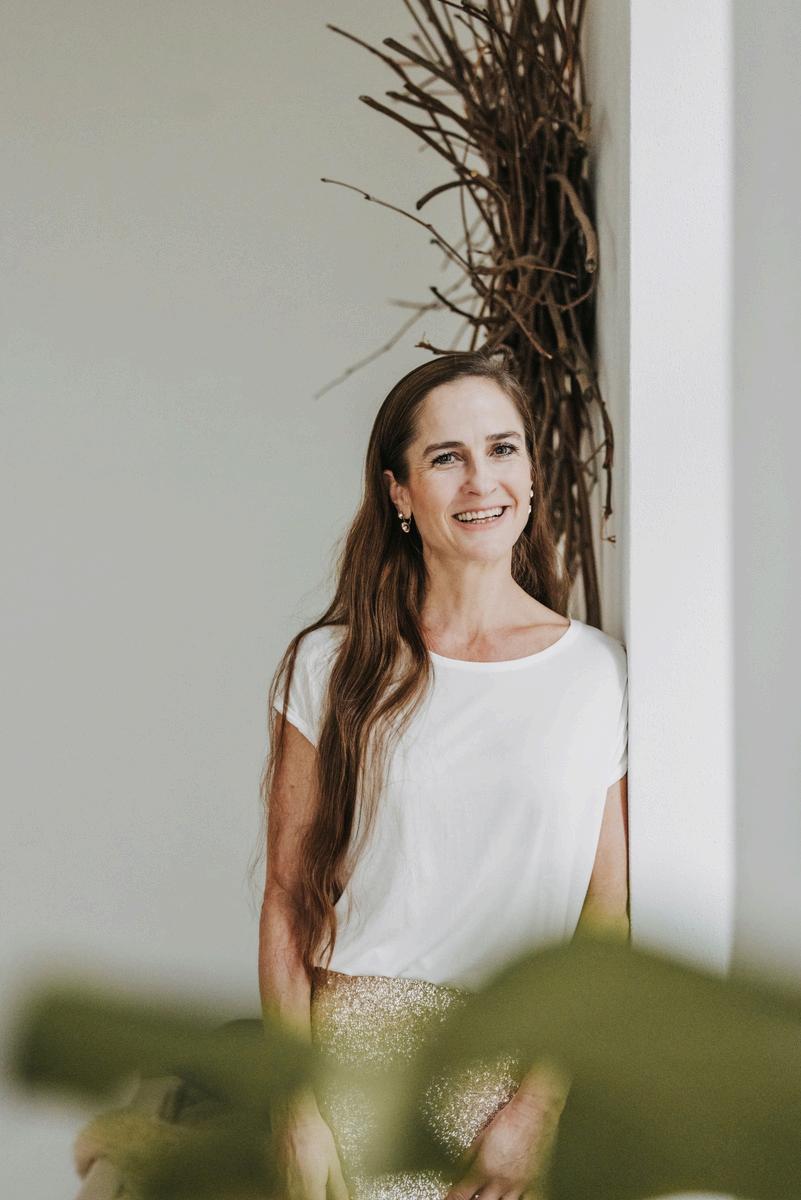
Karin believes that knowledge should be shared generously to empower individuals to take their wellbeing into their own hands As the founder of art of motion, she has developed three comprehensive education concepts – Contemporary Pilates, Slings Myofascial Training, and Anatomy Trains in Motion – and is an international presenter, author, and ambassador for creative living
1. Brené Brown (2021), Atlas of the Heart: Mapping Meaningful Connection and the Language of Human Experience. Penguin Random House UK
2. Candace Pert (1999), Molecules of Emotion: The Science Behind Mind-Body Medicine. Simon & Schuster
3. Thomas W. Myers (2021), Anatomy Trains: Myofascial Meridians for Manual Therapists & Movement Professionals. Elsevier
4. Robert Schleip (2022), The Fascial Network: Our Richest Sensory Organ in International Journal of Therapeutic Massage & Bodywork
5. Robert Schleip, Joeri Calsius, Heike Jäger (2022), Fascia: The Tensional Network of the Human Body. Interoception: A New Correlate for Intricate Connections Between Fascial Receptors, Emotion, and Self-Awareness. Elsevier
6. Marta Beck (2021), The Way of Integrity: Finding the Path to Your True Self. Piatkus Books
7. H.L. Chen, Y.C. Lin, W.J. Chien, W.C. Huang, H. Lin, P.L. Chen (2009), The Effect of Ankle Position on Pelvic Floor Muscle Contraction Activity in Women in Journal of Urology
ISSUE 17 PILATESJOURNAL COM 12 ANATOMY TRAINS
Subscribe to The Pilates Journal today pilatesjournal.com Seeing Known Things in a New Light
Sam’s world view
EACH MONTH WE WILL SUMMARISE THE BEST/MOST RECENT PUBLISHED ARTICLES IN THE INDUSTRY
BASI ASSOCIATE FACULTY AND PHYSIOTHERAPIST
SAMANTHA WOOD
Over the last two decades, there has been a growing body of literature published in medical journals advocating the use of the Pilates method as an effective form of conservative treatment for injury rehabilitation in the field of physiotherapy Pilates has been shown to improve core strength (Emery et al. 2010; Kloubec 2010), increase muscle strength and overall flexibility (Kao et al 2015; Kloubec 2010; Campos de Oliveira, Goncalves de Oliveria and Pires-Oliveria 2015; Sekendiz et al 2007; Segal, Hein, and Basford 2004), promote efficient movement (Emery et al. 2010; Herrington and Davies 2005), improve posture and enhance postural balance (Alves de Araujo et al 2012; Emery et al 2010; Natour et al 2015; Campos de Oliveira, Goncalves de Oliveria and Pires-Oliveria 2015), restore function, and help to manage pain (Campos de Oliveira, Goncalves de Oliveria and PiresOliveria 2015; Rydeard et al 2006; Wells et al 2014) For the benefit of those who need to see scientific evidence, this monthly column is for you!
Each month we will summarize and review one of the best/most recent published articles
Pilates vs. Conventional Exercises for Low Back Pain
Most studies on the efficacy of Pilates for low back pain compare Pilates exercises to a control group (no exercises) It is exciting to see a study with a large sample size that compares Pilates to another type of exercise
In 2021 a group of researchers in India compared Pilates to “conventional exercises” as a treatment program for people with non-specific chronic low back pain At four intervals during the study (baseline, 4 weeks, 8 weeks, and 12 weeks); pain, function, and disability were assessed via subjective testing In this study, 100 subjects between 25 and and 40 years old were randomly assigned to either a Pilates group or a conventional exercise group The conventional exercise group did cat & camel, straight leg raise, pelvic tilt, lumbar rotation, prop-up on elbows, piriformis stretches, and a hip flexor exercise The Pilates group did a set of 6 basic mat exercises Each exercise session was 45 minutes in duration, and was performed 3 days per week for 12 weeks

Although both groups showed improvement in pain reduction and disability at the end of the 12 weeks, the Pilates group’s improvement was much more significant. Thus, the researchers concluded that Pilates is an effective non-pharmacological, noninvasive therapy which helps with pain reduction and functional ability, without any side effects or hazards These results imply that Pilates is more beneficial than conventional exercises in decreasing pain and functional disability in patients with chronic, non-specific low back pain
Manikandan P G Mohan Kumar, V Rajalaxm, C Priya, G Yuvarani, G Tharani, K Kamatchi, Vaishnavi, G Muthu Raj “Effectiveness of Pilates exercises on non-specific low back pain to determine pain and disability” 2021 Biomedicine 41(4): 825-829
Samantha Wood, MPT, MBA, NPCT, RYT, is a licensed physical therapist, a National Pilates Certified Teacher (NPCT), a Yoga Alliance–certified teacher, and an associate faculty member for BASI Pilates She created and teaches two advanced education courses for BASI Pilates: Pilates for Injuries and Pathologies (for Pilates teachers) and Pilates: Integration Into Therapeutic Practice (for rehabilitation professionals). She is the author of Pilates for Rehabilitation
13
ISSUE 17 PILATESJOURNAL COM
COLUMN
Tailoring Pilates: Training Athletes vs.
Seniors
WE COMPARE AND CONTRAST THE DIFFERENCE BETWEEN WORKING WITH ATHLETES AND SENIORS AND HOW YOU KEEP UP THE CHALLENGES REGARDLESS OF YOUR CLIENTS FOCUS

Pilates is an incredibly adaptable form of exercise that can be tailored to meet the unique needs of a wide range of individuals, from professional athletes to senior citizens When working with professional athletes, my focus is on enhancing their performance in their respective sports by improving their strength, flexibility, agility, and preventing injuries The training is intense and specifically designed to meet the demands of their sport, while incorporating core Pilates principles.
I aim to train athletes in a way that complements their regular gym workouts, offering them a different perspective on movement My goal is to help them achieve a wider range of motion, which can lead to increased joint mobility and stability As athletes often have rigorous training schedules, I ensure that my sessions include elements of recovery, such as active stretching and agility work, to help them perform at their best.
I focus on improving their mind-body connection, which is essential for athletes to perform at their peak This involves
teaching them how to move more efficiently, with greater awareness of their body's alignment and movement patterns By incorporating these elements into their training, I can help athletes improve their performance while reducing the risk of injury.
When working with professional athletes, my focus is on identifying areas for improvement to enhance their performance I assess what specific aspects they need to strengthen to excel in their sport I concentrate on teaching Pilates movements that can strengthen any existing injuries or weaker areas they may have Each session is dynamic and responsive to my client's physical and mental state on that particular day. If there's a specific area that needs improvement, I prioritize working on that to enhance their overall performance over time
I don't adhere to a fixed set of exercises in each session; instead, I adapt based on what my client needs The goal is to help them feel and move better, so I focus on movements like spinal flexion, extension, rotation, and lateral flexion to ensure a full-body
ISSUE 17 PILATESJOURNAL COM 14 PROGRAMMING
“I focus on improving their mind-body connection, which is essential for athletes to perform at their peak...with senior clients, my focus is on enhancing their overall quality of life by improving mobility and balance...support[ing] their daily activities.”

workout in each session Consistency in these movements allows me to tailor the session to meet my client's individual needs.
I use a variety of Pilates apparatus to help my clients achieve a more mobile body The choice of equipment and the progression of the session depend on how my client is feeling that day. This approach allows me to provide a customized workout that addresses my client's specific goals and challenges, ultimately helping them achieve a more mobile and functional body
With senior clients, my focus is on enhancing their overall quality of life by improving mobility and balance My approach is “gentle”, emphasizing functional movements that support their daily activities. I aim to build focus, cognitive strength, and connect their mindbody movement I design low-impact exercises that strengthen muscles, improve joint mobility, stability, and posture
While the training is moderate, I maintain a certain level of intensity by gradually increasing the difficulty as the client progresses I ensure to challenge them with quick transitions between exercises, pushing them to think quickly and react faster I limit breaks to keep them moving and engaged throughout the session, focusing on keeping their minds active and bodies in motion
I use the jumpboard to challenge their mind-body connection, offering a fun and different workout experience This low-impact cardiovascular endurance training helps improve joint mobility, coordination, and build muscle strength, all of which are beneficial for seniors
One of my favourite apparatuses to use with seniors is the chair with handles. This apparatus challenges their stability, balance, and strength, helping them build confidence in standing on their own It also strengthens their legs, hips, and feet, key areas for preventing falls Keeping seniors upright during exercise is effective because it addresses their fear of falling, making the workout both safe and beneficial
While the approach to training these different sets of clientele may fluctuate, there is still a huge overlap - the key is I’m tailoring the training to meet the specific needs and goals of each individual This does not change, whether it is for a young athlete in their prime, or a senior looking to enjoy life a bit more By understanding your client's bodies better, instructors can effectively help both sets of clients to not only meet, but in fact, exceed their goals
Here is an example of my approach when selecting exercises for my professional athlete clients:
Injury Prevention-Based Workout Session Planning:
1. Full Spine Movement on the Cadillac: Perform flexion, rotation, extension, and lateral flexion
2 Flexion and Extension of the Spine with Hamstring Stretches: Utilize the push-through bar or roll back bar for these movements, integrating rotation and lateral flexion variations while focusing on hamstring flexibility
3. Abdominal Strengthening:
Use the push-through bar or handles with arm springs for exercises like hundred, teaser, corkscrew, and toe taps,
ISSUE 17 PILATESJOURNAL COM 15 PROGRAMMING
emphasizing rotational movements along with spinal flexion and abdominal engagement.
4 Hip Extension Work:
Work on standing exercises with the rollback bar, arm springs, or trapezius, ensuring the inclusion of lateral flexion, rotation, and extension
5 Barrel Exercises for Hip and Leg Stretching:
Include exercises like leg circles while lying prone, ballet stretches, and rollover for spinal extension with rotation
6 Reformer Exercises for Mobility and Strength:
Incorporate exercises such as Elephant, Up-stretch, Knee stretch, Feet in straps, Front lunges, and Psoas stretch to enhance mobility and strength
Here is an example of my approach when selecting exercises for my senior clientele:
Injury Prevention-Based Workout Session Planning:
1 Chair Exercises for Balance and Strengthening:
Perform standing leg presses, seated leg pumps (footwork), forward fold (hamstring stretch), and single-arm press to enhance ankle strength, hip stability, and leg strength
2 Reformer Exercises for Shoulder Strengthening and Mobility:
Include exercises like Draw a sword, Rotation, Teaser Arms, Serve a tray, and incorporate balance and upper body strength work
3. Lower Body Strengthening:
Utilize exercises such as Feet in straps and Scooter on the reformer
4. Stretching:
Include stretches like Mermaid, Elephant, and Psoas stretching to improve flexibility and mobility
Nicky Lal is the founder and creator of Fuerza Pilates in Los Angeles, California. Originally from Miami, Nicky first encountered Pilates while seeking a daily exercise routine during her tenure as a Graphic Designer in the fastfashion industry Quickly developing a passion for Pilates, Nicky transitioned her career path. She pursued Balanced Body certification as a Pilates Instructor and accumulated valuable experience at various Pilates studios across LA. Nicky's teaching philosophy emphasizes the core principles of Pilates while advocating for its accessibility to individuals of all fitness levels and body types.

ISSUE 17 PILATESJOURNAL COM PROGRAMMING
16


3 + 4 AUGUST 2024 — BONDI, SYDNEY PILATESJOURNALEXPO.COM CONNECTING PILATES PROFESSIONALS

GROWING YOUR BUSINESS MEANS GROWING YOUR TEAM’S SKILL SET
by Alisha Porter
How do you keep your team motivated? ISSUE 17 PILATESJOURNAL COM 26
SMALL BUSINESS
How do you motivate and inspire your team? What are your strategies to keep them engaged? We speak with Owner of Sense of Power Pilates, Alisha Porter, about how she keeps her staff engaged and how this also sets her studio up for continued success.
---------------
I have a small team of three instructors who are incredibly capable humans I deeply value each of them and I am committed to their growth It’s rewarding to see them develop, and I take pride in supporting their journey
Having worked as a full-time instructor since 2016 and now running my own studio, I’ve learned a lot from some of the best in our field These experiences have been invaluable, and today, I get to share this wealth of knowledge as a mentor of Students undertaking their Matwork Pathway, Reformer Pathway and/or Diploma for Pilates ITC
I’m going to share with you some ways that I go about inspiring my team in the hope that it inspires you I understand we’re all busy but this investment pays off greatly for me, and for my longstanding clients too
Identify and Cater to Their Niche Interests
Retaining great team members is always a challenge By providing opportunities for ongoing education and self-mastery, we not only keep our instructors motivated and engaged, but they also become more valuable members of our team and better instructors for our clients
It all begins with understanding each of my team member’s goals and their niche interests Once I understand what they are most interested in I can guide them towards continuing education opportunities that align with their interests. This also helps with matching new clients up with Instructors in order to create better client retention
Provide Ongoing Education Opportunities
I’m always on the lookout for upcoming training opportunities that are appropriate for each of my instructor’s needs, however, I believe that our biggest learnings always come in the implementation, the doing, the self-mastery You can do all of the continuing education available, but if you are not implementing it in your own practice and into your programming for clients, then what is the point?
One way I go about this is by allocating my team members Team Packages so that they have the opportunity to book in and dedicate time for their own practice This is dedicated time with me as the Studio Owner to work with my team on their progression as instructors and as Pilates professionals I’m very open to “play” during these sessions We could apply some of the information and concepts from a workshop, look at repertoire variations or I can assist to help make an exercise more appropriate for a particular client, or play with something I have learnt recently There are usually lots of questions or discussions while moving
Additionally,
Guest Teachers. I love having Instructors from other states come to our studio Depending on the time available, it could consist of a few privates/duets, a guest teaching a matwork or reformer class, or running a workshop on a particular topic or skill These are often opportunities that are in intimate settings with few participants, which means a high level of individual interaction and attention
I also get ideas from other Pilates and Allied Health business owners because of the Business Coaching Group I am a part of called The Clinic Project This is a great way of getting support and ideas from others on what’s worked or what more I could be doing.
I have been fortunate to have some fantastic and capable new graduate Instructors come to work with me They are passionate and keen to move forward quickly. However professional and skills development is something that takes time to gain I think sometimes, that becomes a new concept once people get into a studio setting after graduation That there is more to learn and that it takes practice to get proficient in all aspects of being an Instructor
At the moment there seems to be a trend of wanting to get to the top of the field swiftly. This in and of itself is not a bad ambition! However, building your skill set and experience takes time Starting with a good foundation like high-quality training is an excellent place to begin, but after that, you have to put in the time
To grow takes time, and you just have to DO the time Just like starting any new job role or change in career, you have to start at the beginning There is a period of refining your skills of communication (verbal, tactile cueing, handovers), and implementation of repertoire while managing client contraindications Reflection and self-assessment are all part of this It’s ok to not know something and to seek guidance from a Senior Instructor or Mentor. This process can’t be rushed or fasttracked, you just have to continue to put in the time
Celebrate Growth and Milestones
We also like to celebrate the growth of Instructors and also financially recognise their skill sets and development We celebrate these milestones with our clients so that it is an educational opportunity for the community on what we do and how we value experience and knowledge in the Pilates field as a whole
Team Building Outside the Studio
We make time twice a year for some team building outside of Pilates – usually around the studio birthday and just before the Christmas break It is important that we get together just as people and develop a good rapport When we know each other better as people that supports us professionally too
Thinking Creatively
Some other key initiatives for our team this year include: Our studio participates in community engagement events, which offer a chance for new clients to discover us while creating a sense of excitement and buzz We have two planned through the local council that we will be involved in for 2024 This is also usually a really fun way to get everyone together on the same day
my team has the opportunity to have sessions with ISSUE 17 PILATESJOURNAL COM 19 SMALL BUSINESS
Continuing educat into a two-day Leade domain While not sp education and will ha business and flow int
Throughout the ye photoshoots, filming, and develop their sk great way for them to ownership in the out
Regular, Personalised Feedback
I also make sure we the year and we do a preparation for the y when there is a gap i time It’s also a great and remuneration Th now so many differen sometimes it is like c compared side by sid Pilates business is a studio. They both ha business models Th p q that we seek for our instructors – it relates to what we are teaching, namely individualised programs, which are specific to each client’s needs. We need a base level of knowledge in order to provide that to clients

In summary, if you are struggling to get your team motivated, my biggest advice whether you are running a team, coaching clients, or being a mentor is this:
The easiest way to get stuck, plateau and decline in business is to not seek and respond to feedback. A takeaway from my time working for Lululemon Athletica was that feedback always comes from a place of love Whether it is a pat on the back, constructive feedback or a complaint, the person has taken the time to give it to you in the hope that some positive change will result. We always ask for feedback; in the studio, via our newsletters and in reviews It is our best way of continuing to grow and making our clients the focus of our business – it is why we are there in the first place!
It's also important that we are mindful of the trickle-down effect If you are not filling your own cup, then you are depleting your resources and may be left with nothing to give to those around you, including your family
Some questions I ask myself and my team are: Are you doing your own self-mastery with someone that inspires you? This might be someone on your team or someone completely external
Do you have a business coach or a business accountability group? Look for options outside of the Pilates industry too. I am involved in three development programs: one for business coaching which also includes other allied health businesses, one for marketing accountability, and one specifically for Pilates mentoring.
Make time for yourself and your self-development and your team will follow suit too!
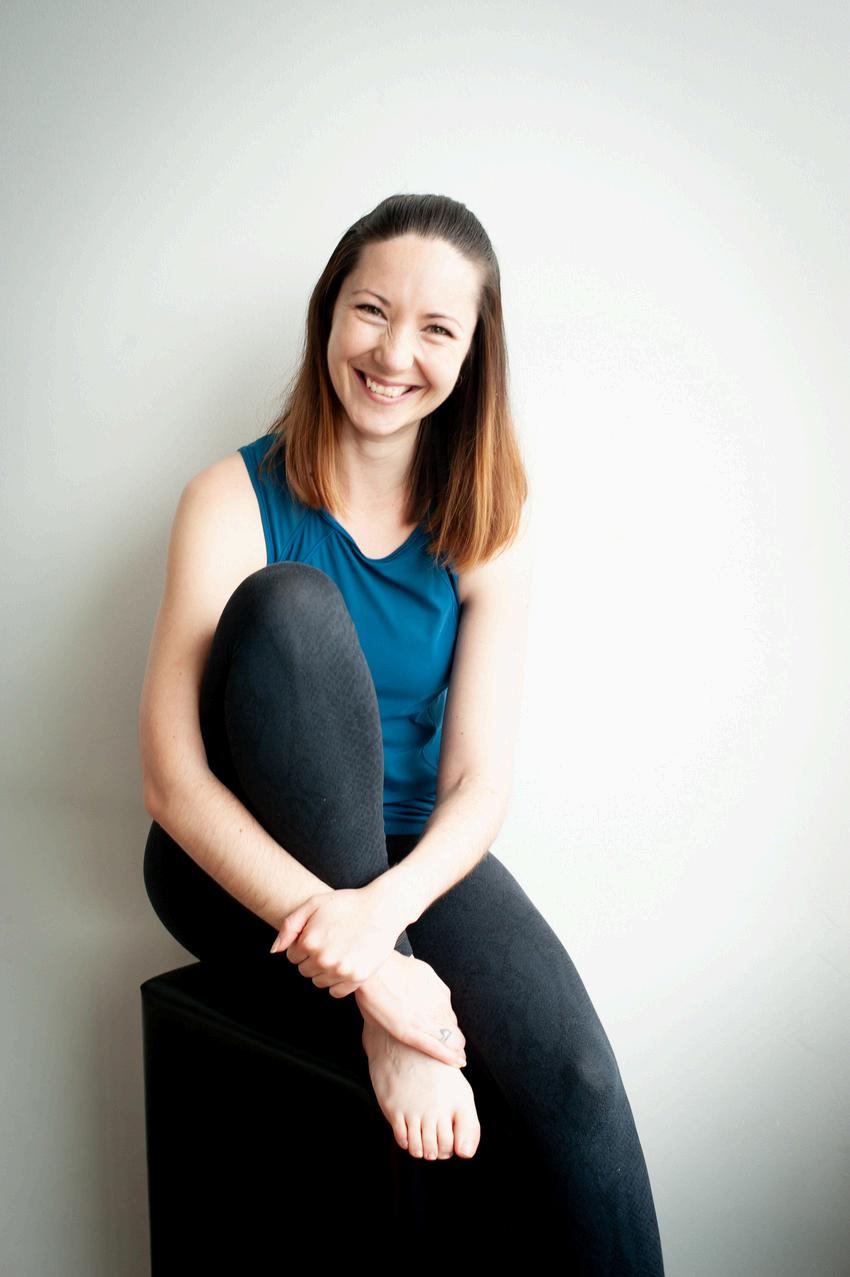
a Diploma qualified Pilates Instructor with Pilates ITC. Her goal at her studio is to help clients move freely with confidence and feel fully connected to their bodies. Her work in studio focuses on providing high quality Pilates instruction to their local community, rehabilitating clients from injuries, helping individuals manage conditions such as MS, Parkinsons and Scoliosis, and athletes and dancers looking to enhance their training
ISSUE 17 PILATESJOURNAL COM 20 SMALL BUSINESS


BONDI, SYDNEY PILATESJOURNALEXPO.COM STAY CURIOUS. STAY CONNECTED.
3 + 4 AUGUST 2024 —
Elevating Pilates Standards
ENSURE YOU HAVE THE INDUSTRY STANDARD IN EQUIPMENT
by Chris Skinner
As the owner of HF Industries and the exclusive distributor of Balanced Body® equipment in the Asia Pacific region, I've had the privilege of witnessing the transformation of Pilates across our region Yet, amidst this vibrant landscape of passion and dedication, one thing remains clear, the pivotal role of quality equipment in shaping exceptional Pilates experiences Allow me to share our journey and insights into the significance of Balanced Body products
As an equipment supplier, it’s our job to bring to the marketplace products and ideas that in turn create opportunity and success for those that purchase such products
From the beginning, we believed the best way to succeed with this was to only supply the best of the best products available, provide the best possible support systems, and offer programs and education that generated the best returns
To put it simply, show our clients how to make money by purchasing the products and services we offered
Such programming had only one prime function to achieve. The user had to enjoy it Achieve that, and they would want to do it again, and again and ‘Have Fun’ doing it After all, it was the name of the company, HF Industries
When HF Industries embarked on our mission to redefine Pilates standards across the Asia Pacific region, we sought a partner who shared our unwavering commitment to quality, safety, and innovation. Balanced Body emerged as the perfect ally.
Their global reputation for crafting equipment that epitomises durability, performance, and safety resonated with our ethos
As the exclusive distributor of Balanced Body, we've had the privilege of introducing countless studios and professionals, to the transformative capabilities of the Allegro Reformer Each machine proudly bearing its unique serial number, stands as a beacon of accountability, traceability, and uncompromising quality
But why does investing in quality Pilates equipment matter? The answer lies in longevity, trust, and peace of mind. While the allure of cheaper alternatives might tempt some, the hidden costs from frequent repairs to potential safety hazards, can jeopardise

the integrity of our studios and compromise the well-being of our clients We want everyone who uses our products to have the best experience It pains us when we hear stories about people thinking they have purchased our product, to soon realise it was a copy
When one becomes successful with a product, there are soon copies! In our case with such clones, some choose to use our name and images to give an impression their copies are Balanced Body.
We have patents, trademarks, and Intellectual Property over all our products This has been done for two reasons To protect ourselves from such situations and protect those who have purchased our products Everyone suffers when others look to compete under false pretences
In contrast, the Balanced Body Allegro 2 Reformer backed by HF Industries’ unwavering support and service, promises a seamless blend of performance and durability Its robust construction and thoughtful design ensure years of trouble-free operation, empowering studios to deliver world-class Pilates experiences with confidence
Choosing HF Industries as your trusted supplier means aligning with a legacy of excellence, innovation, and unmatched customer support Our team is dedicated to providing comprehensive training, maintenance, and unparalleled service ensuring that your investment yields exceptional returns for years to come
In conclusion, the choices of Pilates professionals and studio owners resonate beyond studios walls They shape the fabric of our movement, define our commitment to excellence, and elevate the Pilates landscape to new heights When it comes to selecting a Reformer machine, let's prioritise quality, innovation, and longterm partnership
With HF Industries and Balanced Body by your side, you're not just investing in equipment; you're forging a partnership that promises a lifetime of success, growth, and transformation So, the next time you're in the market for Pilates equipment, remember to choose wisely and let's elevate Pilates standards together.
HF Industries is the distributor for Balanced Body Australia and New Zealand. Contact them to find the best equipment for you.
21
ADVERTORIAL ISSUE 17 PILATESJOURNAL COM

“...the choices of Pilates professionals and studio owners resonate beyond studios walls. They shape the fabric of our movement, define our commitment to excellence, and elevate the Pilates landscape to new heights. “
21
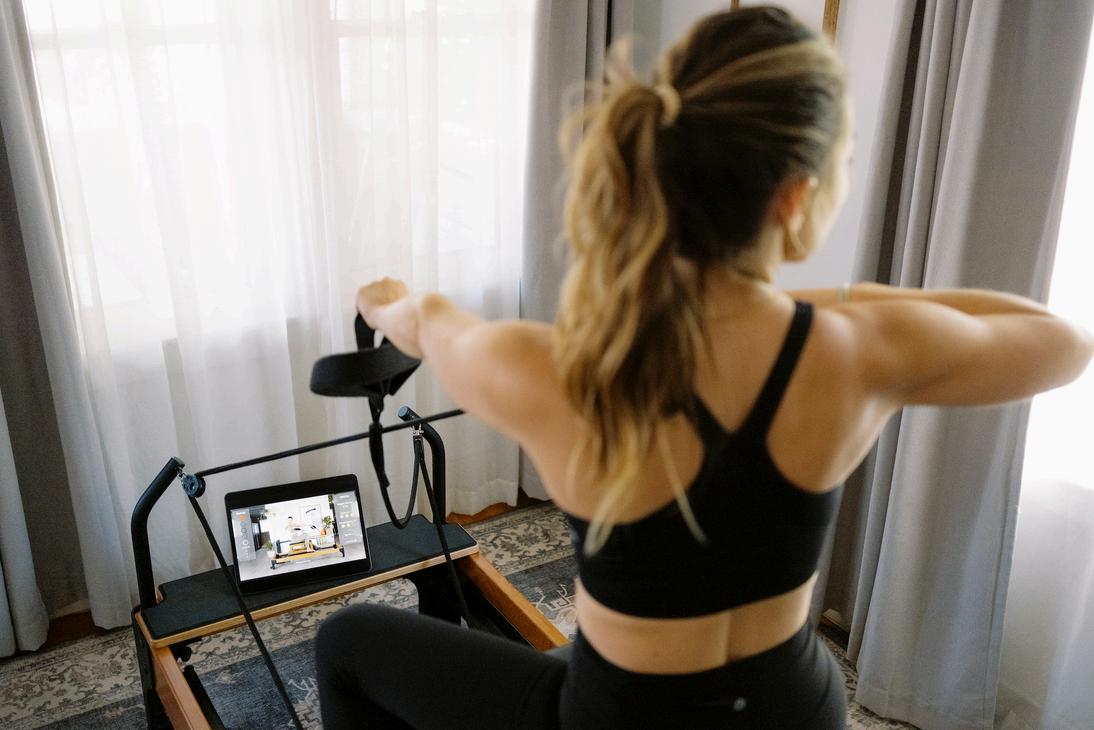
Flexia: Transforming Pilates with Technology
DISCOVER THE NEXT EVOLUTION OF PILATES WITH DATA-DRIVEN PERFORMANCE METRICS
by CJ Zarb
How often have you had a client checking their Apple Watch in a session, assessing if they are getting benefits from their reformer workout? You can tell from the look on their face that they are having a hard time trying to make sense of the very little data and information provided by their smart device It doesn’t seem to match their experience of feeling taller and stronger than when they first walked in. They usually leave thanking you for the experience, and yet their activity trackers don’t tell them anything about why that workout felt so good
The Founder & CEO of Flexia identified this opportunity to enhance reformer sessions by giving clients access to real-time data about their workouts straight from the reformer machine She saw this gap in the market and jumped right in If you haven’t yet heard of Flexia, Kaleen Canevari is making waves by revolutionising how we think and understand the data and science behind a Pilates workout

Kaleen's journey from an active hiker and soccer player with chronic pain and ACL injuries to becoming a devoted Pilates practitioner and instructor is the foundation upon which Flexia is built After tearing her ACL twice and dealing with chronic pain for years, her career as a mechanical engineer landed her a job with one of the largest reformer manufacturers in the United States where she discovered the healing power of reformer Pilates. "Within six weeks of taking classes, I felt the benefits and less knee pain and I was hooked," Kaleen recalls This personal success inspired her to delve deeper into the practice, completing her teacher training while making a career move to support studios across the US as a reformer technician This travelling business, The Fit Reformer, assisted Pilates studios with hands-on equipment maintenance and care, furthering Kaleen’s expertise of the mechanics involved in teaching Pilates.
ISSUE 17 PILATESJOURNAL COM 23
ADVERTORIAL
"I heard countless stories from studio owners and clients about their issues with existing machines," says Kaleen These insights into the limitations and potential of Pilates equipment sparked her vision for Flexia "I wanted to empower the end user," she explains
So in 2022 Kaleen raised $4M in seed funding to build out her concept for Flexia and ship the first units to customers, expand the content library, and further develop a personalized Pilates experience
So, what sets Flexia equipment apart? The Flexia Reformer is designed to provide immediate feedback during and after each class, measure progress, and help users decide what to do next in the Flexia Online Studio "It's like having an accountability partner at home," Kaleen states But she is quick to clarify, "It's not replacing instructors I envision this technology someday alongside instructor-led classes in the studio to enhance what they are already doing "
Kaleen firmly believes in the irreplaceable value of in-person classes "I don't believe a computer can teach better than a Pilates instructor I strongly believe that talented instructors are worth their weight in gold But most of us know our clients could get better, faster, if they had a meaningful way to practice outside the studio What Flexia enables is an elevated at-home experience to keep folks accountable and motivated with data that actually correlates to Pilates," she elaborates This approach not only benefits home practitioners now, but Kaleen envisions it complementing instructor-led, in-studio sessions one day, offering more data-driven insights for students and instructors alike
Flexia is creating a new language for Pilates by introducing measurable behaviours within movement sessions. Kaleen emphasises the importance of this development: "When you think about professional sports, elite sports, every backroom training centre has a reformer The thing is, the reformer is the only piece of equipment that doesn’t have any data associated with it This lack of data makes it challenging for athletes and their trainers to see how Pilates can fit into their rigorous training schedules Flexia aims to change this by designing a system that tracks and measures progress in a meaningful way,” said Kaleen.
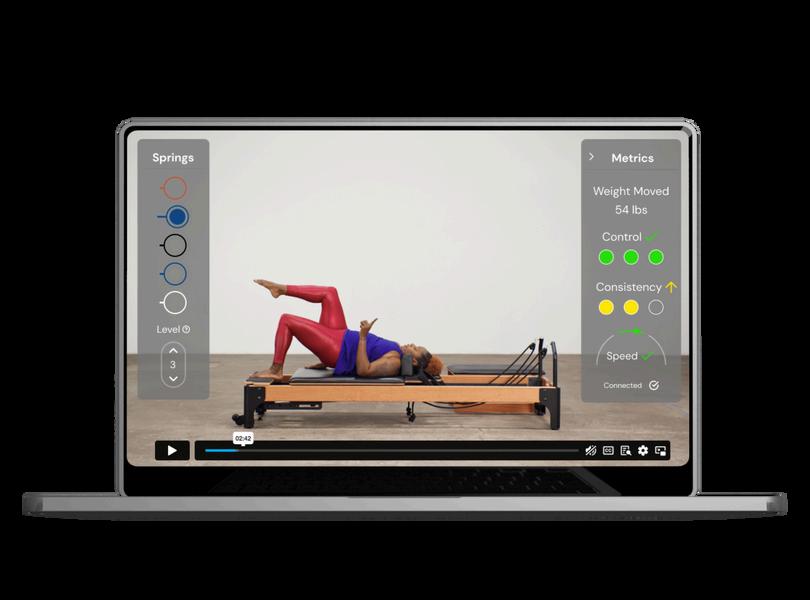
At the core of Flexia's technology is the Movement Quality Score (MQS) This unique metric evaluates how well a user performs in each class, considering what the instructor asks of the student and comparing it to what they actually produced "We could give my grandma and a pro athlete the same class, and while they might have different reformer settings or exercise variations, their scores will be comparable," Kaleen explains A good MQS score ranges between 50 and 80 out of 100, with the goal being to work in the Zone of Progress challenging enough to drive improvement but not so difficult as to cause discouragement
The Flexia Reformer comes equipped with sensors that provide real-time feedback These sensors measure load, distance, speed, and acceleration, contributing to the MQS "There are four real-time metrics we report to the user, including weight moved each repetition, a control score, a consistency score, and a speedometer so they know if they are moving at the pace we ask them to," Kaleen details After each workout, users receive a report card that highlights their performance, identifying strengths and areas for improvement
Despite these technological advancements, Flexia's goal is not to replace the human touch in Pilates “Pilates teachers are highly trained experts with the ability look at an individual and make quick, critical decisions about their performance and decide in the moment what feedback to give based on the student’s goals, progress, and abilities In many ways, consumer technology isn’t quite as sophisticated as an instructor yet But what we can do is give really important feedback about the basics that computers are really good at measuring, like counting, comparing, and remembering We leverage those technological strengths to make the biggest impact for our users ”
The Flexia Reformer is studio-grade and designed to fit a wide range of body sizes and shapes. "It fits more body sizes. It’s more intuitive to use and is made to feel like the professional reformers in a studio " Kaleen describes The reformer has a shorter footprint than others on the market, but still achieves longer carriage travel, making it compact yet accommodating for larger torsos, broader shoulders and wider waistlines It also stands upright, making storage convenient “Inclusivity is a significant aspect of our design philosophy, ensuring that more people, regardless of body type or mobility level, can benefit from Pilates,” she said
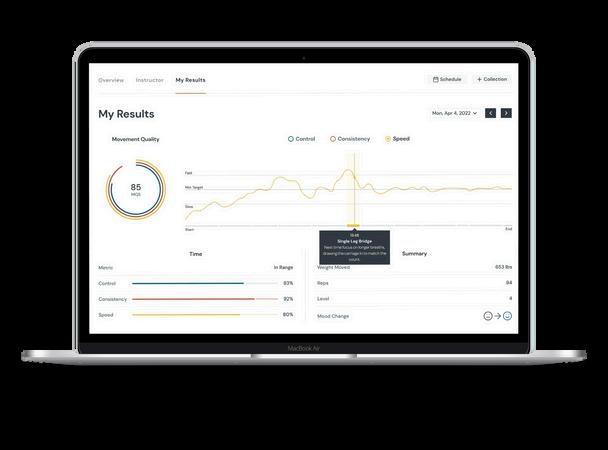
ISSUE 17 PILATESJOURNAL COM 24 ADVERTORIAL
The Unique Vision of Flexia
A Studio-Grade Reformer for Everyone
Integrating Technology and Tradition
A New Language of Pilates
The Future of Pilates with Flexia
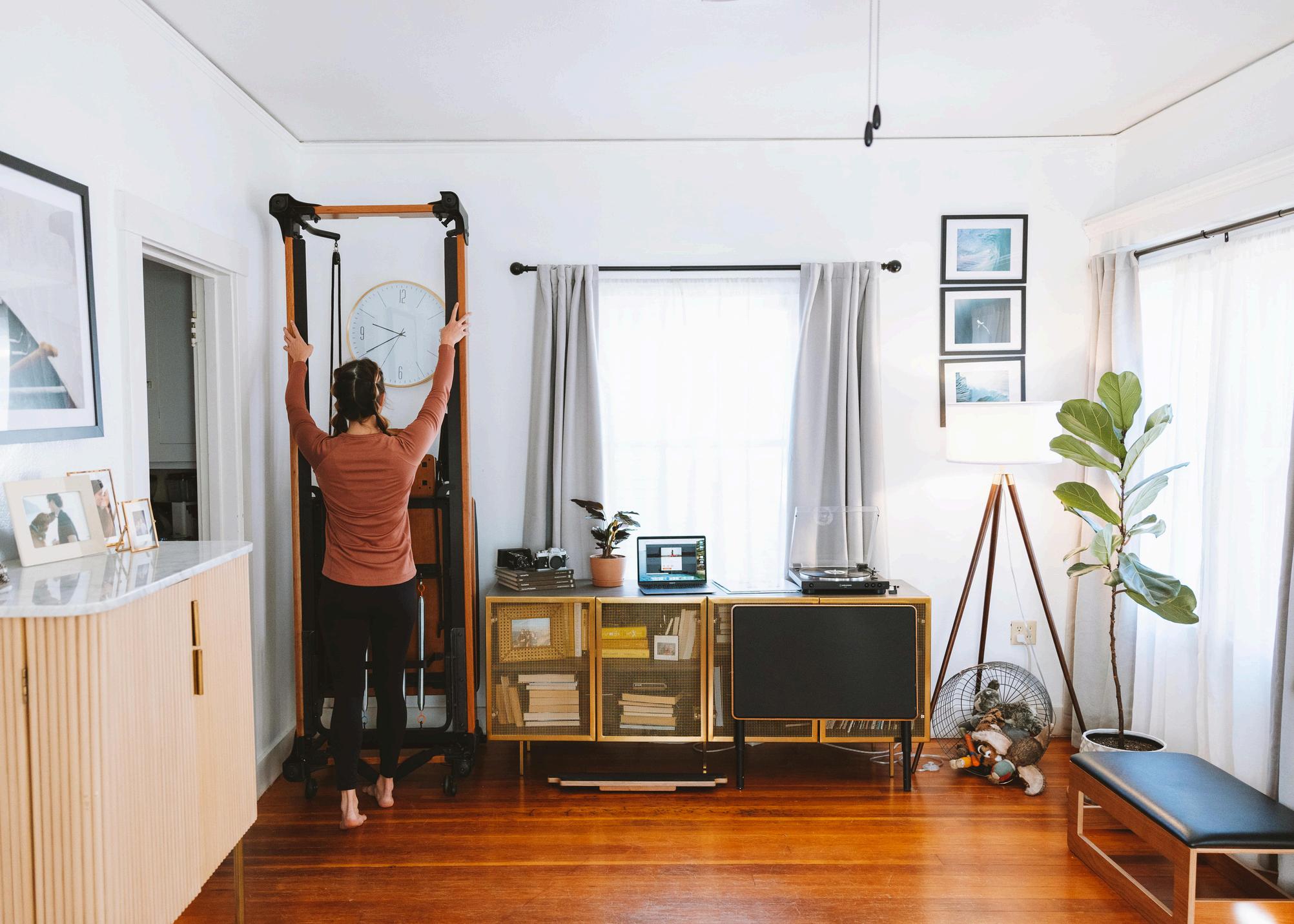
's about the future Kaleen r in a studio setting is data-driven insights to hred of data that meant e unstoppable," she asserts out the history and goals of xercises for their clients, and heir sessions, clearly ng the overall Pilates
Flexia is ensuring that landscape of fitness and e will be left behind and we mic and effective practice for
ineering and is a tructor, with deep roots in having worked in the ness equipment industries er time between teaching ng the country as an hnician.
rks page here.

ISSUE 17 PILATESJOURNAL COM 25 ADVERTORIAL
Leaving the lunges behind but not your glutes
LEARN HOW TO GET OPTIMAL GLUTE ACTIVATION WITHOUT EVER HAVING TO TEACH YOUR CLIENTS A LUNGE
by Kira-Leigh Rule

Understanding Glute Activation: Why It Matters
Before diving into alternative exercises, let's first understand why glute activation is so important. The gluteal muscles comprising the gluteus maximus, medius, and minimus are among the body's largest and most powerful muscles They are crucial in hip stability, pelvic alignment, and overall lower body strength Proper glute activation not only enhances athletic performance and functional movement but also helps prevent injuries such as lower back pain, knee issues, and hip instability
Challenges with Lunges: Not One Size Fits All
While lunges are a popular choice for targeting the glutes, they may not be suitable for everyone Some individuals may have mobility restrictions, joint issues (knees, hips or ankles), or balance concerns that make lunges uncomfortable or inaccessible Additionally, certain variations of lunges such as forward or reverse lunges may place excessive strain on the knees or lower
back if performed incorrectly As Pilates instructors, it's essential to provide alternatives that cater to all clients' needs and abilities
Alternative Exercises for Glute Activation in Pilates Bridge Variations:
Start by lying on your back with knees bent and feet hip-width apart
Lift your hips towards the ceiling, engaging your glutes and core
Hold for a few seconds before slowly lowering back down
To intensify the exercise, try single-leg bridges or elevate your feet on a stability ball.
On reformer - you can challenge clients by making springs lighter for more hamstring focus
Clamshells:
Lie on your side with knees bent and hips stacked
Keeping your feet together, open your top knee away from the bottom knee while maintaining tension in the glutes
ISSUE 17 PILATESJOURNAL COM 26 PILATES TECHNIQUE
Slowly return to the starting position and repeat on the other side
Focus on maintaining stability in the pelvis throughout the movement
On reformer - you can do this with strap around the knee in side-lying or incorporate in with side-lying arms in strap
Pilates Squats:
Stand with feet hip-width apart and toes turned slightly outwards
Engage your core and hinge at the hips as you lower into a squat position, keeping your knees tracking over your toes
Press through your heels to return to the starting position, squeezing your glutes at the top
Keep your spine neutral and avoid rounding or arching your back
On reformer - you can perform on heavier springs for more glute medius activation and include dumbbells and skaters
Lie on your side on the reformer carriage with your top foo the footbar
Press the carriage away by extending your leg while maintaining a neutral pelvis and engaging your glutes
Slowly return to the starting position with control, focusing the eccentric phase of the movement
Adjust the resistance to match your strength level and avoi locking out your knees at the top of the movement
Progress by adding in knee waves or inner thigh lifts of bot leg
Side-Lying Leg Press:
Lie on your side with your bottom leg bent for support and top leg extended straight
Place a resistance band around your top foot and hold ont other end for tension
Press your top leg away from your body against the resista of the band, engaging your glutes
Slowly return to the starting position and repeat for the des number of repetitions before switching sides

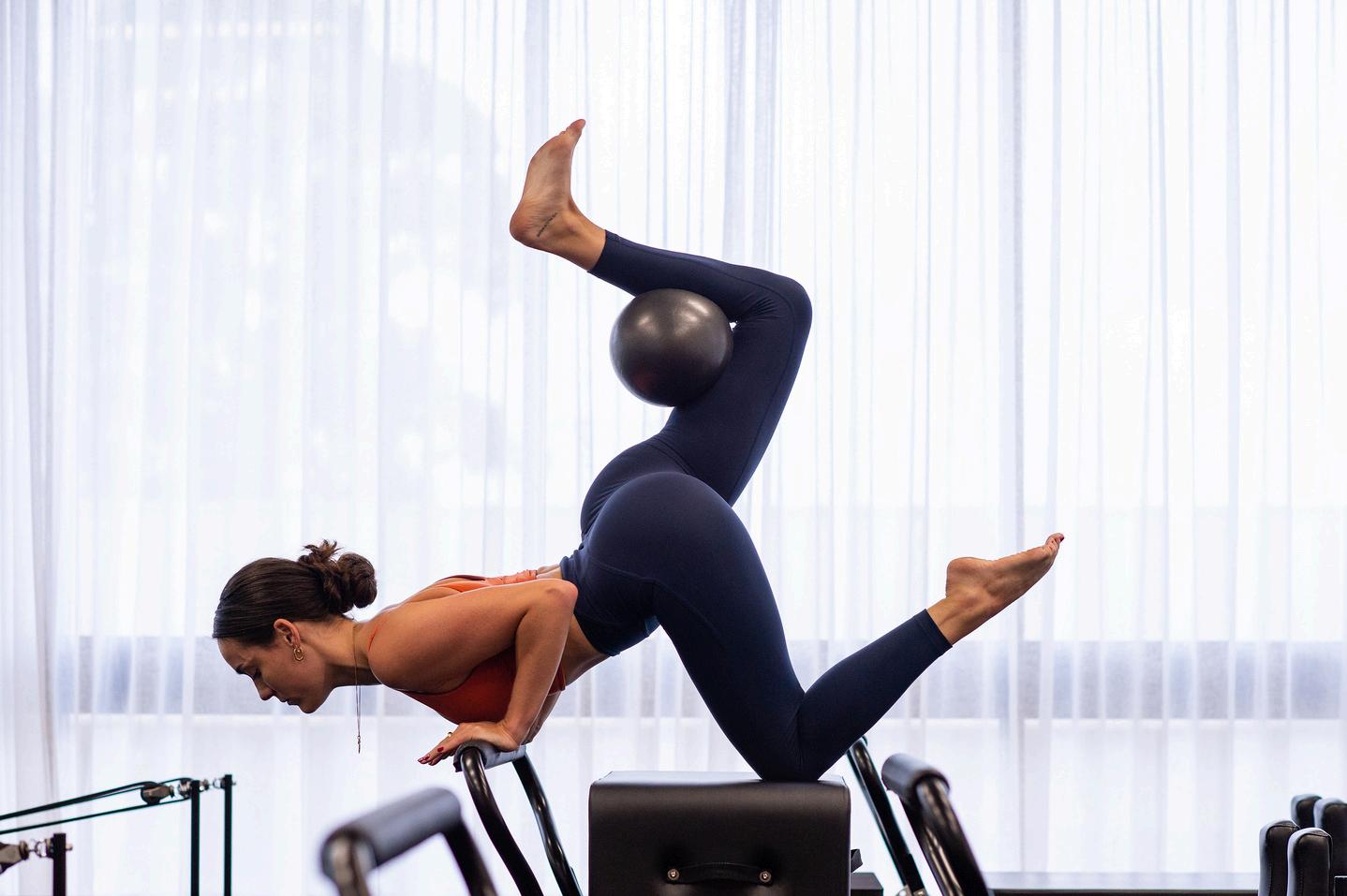
On a reformer - you can place a strap around the foot Lighter spring for more stability muscle work and heavier spring for more strength work.
Now that you have a variety of alternative exercises to cho from, it's time to incorporate them into your Pilates classes by assessing your client's needs, goals, and abilities, and se appropriate and effective exercises for each individual Challenges often arise when clients underwork or overwor glutes, leading to imbalances and compromised movement patterns. To address these challenges:
Proper Form and Cueing: Encourage clients to maintain neutral spine and pelvic alignment while performing glute-f exercises. Cue them to press through their heels and enga glutes to lift or lower the carriage For example, during a br exercise, cue clients to visualise squeezing their glutes as i were holding a pencil between their cheeks
Mindful Movement and Mind-Muscle Connection: Guide to focus on their mind-muscle connection, consciously con their glutes throughout the movement Remind them to avo overarching the lower back or pushing through the knees, can lead to compensations in other muscle groups

ISSUE 17 PILATESJOURNAL COM 27 PILATES TECHNIQUE
Leg Press on the Reformer:

Avoiding Compensation: To prevent compensation, cue clients to relax their shoulders and neck, ensuring that the glutes are doing the majority of the work Encourage them to maintain a stable core and avoid excessive arching or rounding of the spine Use tactile cues, such as placing hands on the glutes to feel the engagement, and verbal cues, such as "feel the glutes working, not the lower back or hamstrings," to reinforce proper activation
By prioritising form, mindfulness, and individualised cues, Pilates instructors can empower their clients to achieve proper glute activation, leading to more effective and rewarding workouts
By expanding your repertoire of glute activation exercises beyond lunges, you can provide a more inclusive and accessible Pilates experience for all clients Whether you're teaching group classes or working one-on-one, these alternative exercises will help you achieve optimal glute activation and support your clients in reaching their fitness goals safely, comfortably and effectively
Kira-Leigh is a licensed physiotherapist, certified Pilates instructor, and studio owner of BODY FORM with a Clinical Pilates Diploma. As the founder of the Anatomy Academy online course, she specialises in functional movement, injury rehabilitation, and professional education for Pilates instructors.

28 ISSUE 17 PILATESJOURNAL COM PILATES TECHNIQUE
Turning out Soccer Players
SOCCER PLAYERS ARE SEEING MORE KNEE INJURIES, AND PILATES PRACTITIONERS CAN HELP BY INTEGRATING BODY ALIGNMENT AND MOVEMENT EXERCISES TO REDUCE INJURIES
byHeidiWright
FISTD FCUSA FinalDiplomaNCPT
The game of soccer, otherwise known as football, is a very popular sport played worldwide Soccer’s growing popularity brings a rise in injuries, particularly to the knees Is there a role we could play as Pilates practitioners to assist this special population? Interestingly, soccer and ballet share similar body positions for kicking and running While ballet dancers learn these positions early, minimizing injury risk, soccer players often lack this foundation Young ballet dancers receive extensive training in proper body alignment, soccer players on the other hand lack this focus leading to potential problems as the game intensifies Soccer coaches can take a leaf from a ballet instructor’s notebook and the Pilates repertoire by introducing specific exercises into their training regime that would address strength and flexibility while taking the time to consider how to execute proper movement, body positions and alignment With less injury, the athletes will move to a higher level within themselves and in the game
It was from watching play after play waiting for the players to grab at their hamstrings, quadriceps or the renowned anterior cruciate ligament (ACL), their faces racked with pain as they clutched at the useless knee that triggered my mind to question their basic body positions compared to a dancers’ basic ballet positions or even the planes of movement we utilize in our Pilates teaching Could soccer players be trained to use their bodies in the basic ballet positions in some areas of their game ?
The ACL injury is the bane of the modern professional footballer An anatomical theory must be addressed to safely put the kind of ballistic force on the knee joint that is needed to move a ball at a pace over sixty yards, or the torque that must be involved in being able to pass the ball anywhere in a hundred and eighty degree arc no matter where the hips are facing. Kicking the ball involves the entire body including rotation and reciprocal motor control Inertia is unquestionably prevalent during the entire game, which leads us to think about arthrokinematics and its’ newly recognized relevance.
The knee joint is particularly vulnerable in soccer due to the constant stress of kicking, changing directions, and absorbing impacts. The basic kick in soccer is with the instep, the leg in a straight line from the knee down, and the ball being driven off the laces of the soccer boot The kick is therefore done in a very
“ballet like” position requiring flexibility of the hip joint Do soccer coaches teach this or acknowledge what it takes to achieve this body position, or the years involved in training and stretching, or even that turn out is initiated in the hip joint and not the ankle or the knee?
Early ballet training teaches the dancers to execute their steps or movements in a manner that assists in achieving the required technique and aesthetic qualities involved in their discipline Fewer injuries will occur with correct training There are eight body positions used in most methods of ballet The most common positions taken from the balletic body positions used in soccer are the following: croisé devant (crossed in front), enface (hips facing to the front) and effacé (sideways, eclipse, shaded) Using these positions, it is quite simple to perform, the movements of a Battement Tendu, Battement Dégagé or Grand Battement These are also the body positions used for kicking and running after the ball in soccer Though players do run and pass the ball sideways and backwards it is primarily a forward (en avant) playing sport, corresponding to ballet, where the majority of moves are directed towards an audience
Why then can we not incorporate the same training from our Pilates repertoire? Surely some of us do Wouldn’t it be wonderful if we could get entire teams to train in Pilates, whether junior, pre professional of professional? Coaches would need to be approached and willing to participate The players would need to be willing to participate in a manner that could present the association between the two disciplines.
Pilates practitioners can assess individual weaknesses and imbalances, creating targeted exercise programs There is so much to choose from whether on the equipment or not. Footwork, Feet in Straps, Mermaid, Standing Hip Stretch, just to name a few, and that is merely some examples on the Reformer I clearly remember whilst training with both Polestar Pilates and Lolita San Miguel in Puerto Rico, playing with the Standing Series /Splits in all the body directions just for fun as most of us had a dancing background Could some of these theories and examples be points to consider when evaluating injury risks and causes? It is important to note that pushing for too much rotation can be as detrimental as too little The teacher or coach must initially evaluate the dancer’s and player’s natural turnout to better
ISSUE 17 PILATESJOURNAL COM SOCCER PLAYERS AND PILATES
“It is important to note that pushing for too much rotation can be as detrimental as too little. The teacher or coach must initially evaluate the dancer’s dancer’s and player’s natural turnout to better understand their limitations and imbalances. “

understand their limitations and imbalances This is much like we do in Pilates with our screening Assessing the situation first will guide the teachers, coaches and practitioners in selecting the correct exercises regardless of the direction of the movement as a tremendous amount of stress is placed on the ligaments and muscles in and surrounding the knee
The area of most danger to the soccer player is the knee, whether due to the force of kicking the ball, tackles, alignment, or an incorrect body position The knee is a synovial modified hinge joint We are all familiar with the muscles, tendons, and ligaments of the knee and what maintains the stability of the joint, including the anterior and posterior ligaments The anterior ligament prevents hyperextension of the knee, and the posterior ligament prevents the femur from sliding off the tibia When the knee is flexed, these ligaments loosen and allow slight medial rotation The quadriceps and the iliotibial band also play a part in stabilizing and keeping the knee straight anteriorly, thus requiring strengthening exercises easily acquired through Pilates training It is not surprising that most injuries occur in the medial compartment or anterior cruciate ligaments One cannot help but believe this is due to a cumulative effect, however, can we consider that the kicking leg is also suffering from the shear force and body position during the kick?
Could we as practitioners encourage coaches to be more observant in possible deficiencies in technique, lack of fitness, incorrect leg and body positions, muscle imbalance, and measures
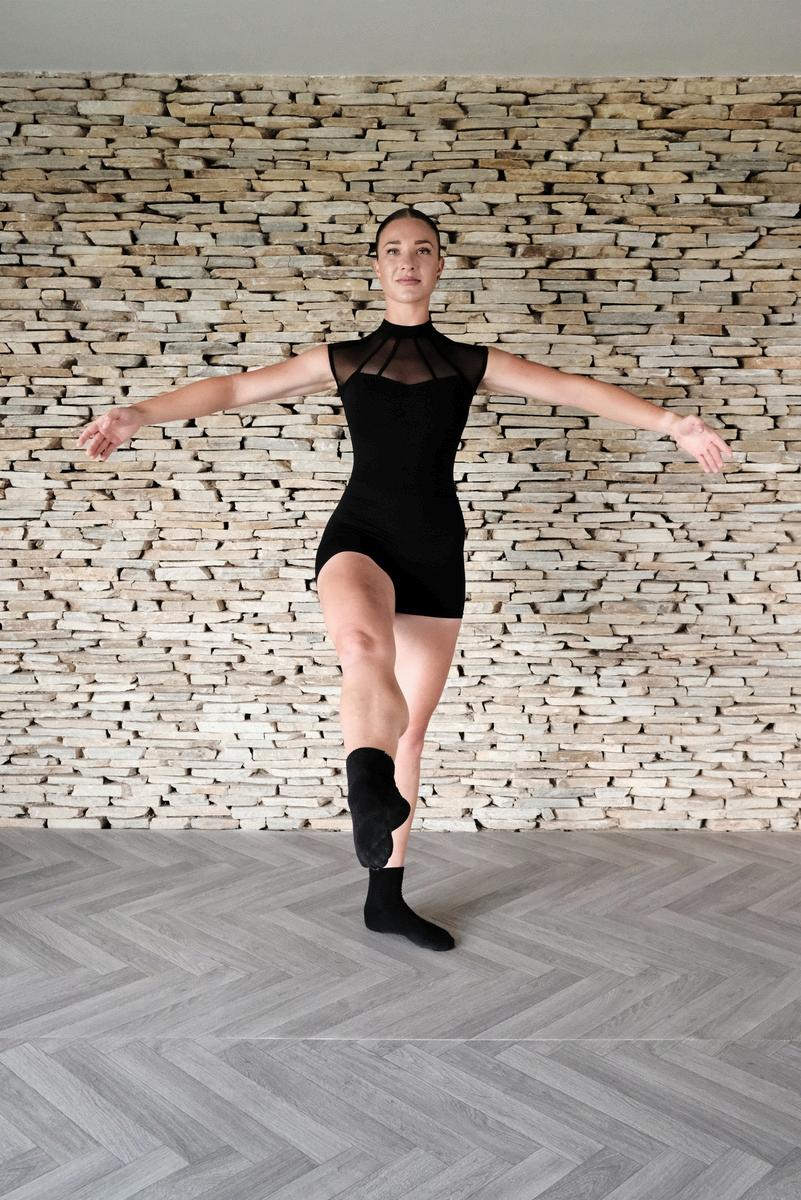
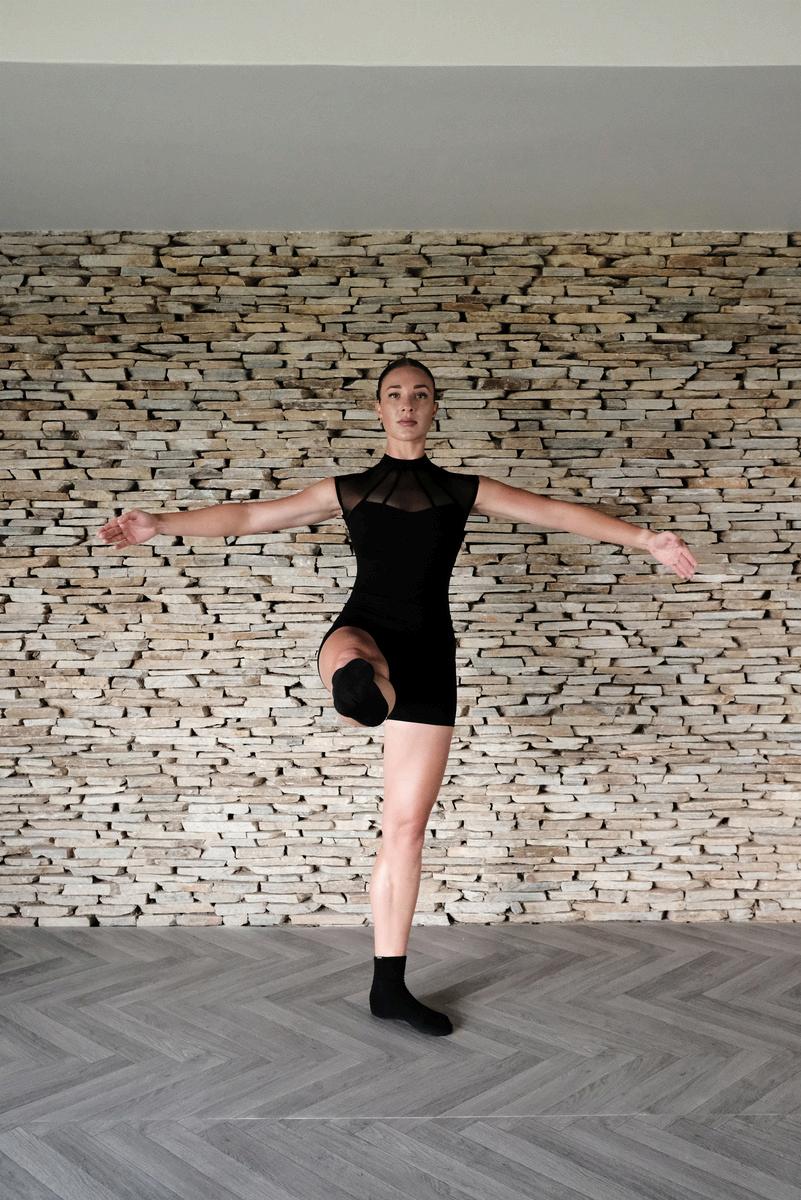
ISSUE 17 PILATESJOURNAL COM 30 SOCCER PLAYERS AND PILATES
of strength in all muscle groups? I am sure some coaches are proficient in these areas, but a deeper awareness could be made A working knowledge of the mechanics of the leg is essential for all of us The diversity of Pilates exercises can keep the training fresh and fun at the same time
There are a few other areas where soccer coaches can invest to help avoid serious knee injury in conjunction with this proposed addition to their training regimen Wearing cleats that are too long for the surface on which a game is played is a well-known factor in causing knee injury A thought to ponder is the wearing of loosefitting uniforms This presents another problem for the coaches, as they are unable to see the correct alignment of the leg clearly to the hip joint, and further up the spine, albeit loose fitting uniforms maximize the freedom of movement Dancers traditionally wear tight fitting tights and leotards that allow a view of how the entire leg and body is working This allows dancers to also have a maximized freedom of movement in their practice clothing but oddly enough at times, do not have the freedom during performance
The width of a person’s hips and the angle of the femur may also influence the soccer player’s proneness to injury Female soccer players, dancers, and female athletes exhibit the latter variants more often than men and are therefore more prone to knee injuries. This could be due to several reasons including the ligaments supporting the angle of the femur, lax ligaments during puberty, and body changes during menstruation Female soccer players may also be more prone to arthritis in the knee joints in later life due to additional stresses during pregnancy and hormonal fluctuation
In conclusion, by incorporating Pilates principles and exercises into soccer training, coaches can potentially create a well-rounded training program that fosters strong, resilient players less susceptible to injuries This collaboration between Pilates practitioners and soccer coaches has the potential to significantly improve player well-being and longevity in the sport. Perhaps with the correct information and the willingness to strive to improve the risks of injury, soccer coaches just might be able to “turn out” better and stronger players
Heidi Wright is a Master Teacher in the genres of Pilates and Ballet. She has been an International and residential guest instructor, lecturer, practitioner and published writer in both genres since 1992 and is a graduate in Pilates Mat, Allegro, Studio and Post Rehabilitation with Polestar Pilates and with Pilates elder Lolita San Miguel. She is NCPT and a member of the PMA.


References
Dr. J. Dickerson (personal communication of significance of topic) Faulkner, C. (1993). Applied anatomy and physiology relating to dance. Dr. P. Glengarry (personal communication on hip to knee alignment) M. Hailwood (personal communication on soccer coaching) Soderman, K. (2002). Risk factors for leg injuries in female soccer players; a prospective investigation during an outdoor season. Soccer Journal, Dr. M. Williams (personal communication on correct anatomical application,) T. Wright (personal communication on soccer coaching, injury prevention, training and playing technique)

ISSUE 17 PILATESJOURNAL COM 31 SOCCER PLAYERS AND PILATES
Let’s stop drawingin the abdominal wall during Pilates classes: Part I
READ WHY THE “ABDOMINAL DRAWING-IN”CUE MAY NOT BE THAT BENEFICIAL AS ONCE THOUGHT
byJulioCesarAragónSalamanca
P.E.S.S.,M.P.E.,C.S.C.S.
The Pilates method is characterized by a list of principles, two of which are Breathing and Centering The Breathing principle pays a great deal of attention to the localization of the breathing movement and the organization of the inhalation and exhalation during the different phases of the exercise The Centering principle arises as a development of the traditional principles, and it requires concentration on the “center,” a continuous band front and back, between the bottom of the ribcage, and the line across the hip bones (Latey, 2001) As a result of the combination of both principles, it has been suggested that during the Pilates Breathing pattern, a voluntary and conscious activation of the abdominal muscles, focused on drawing in the abdominal wall, and paying attention to the behavior of the abdominal region for the correct activation of the transversus abdominis muscle (Merrithew Corporation, 2001).
In the last few years, several studies have provided evidence that the “abdominal drawing-in”cue may not be that beneficial, and it may even impair stability and control of the lumbo-pelvic region within the healthy population (Aragon Salamanca, 2024) The goal of this article is to provide a new perspective a clear “Take-PilatesClasses” Messageon whether or not this abdominal drawing-in maneuver should be a rule applied by Pilates practitioners. We strongly believe that it is very important to bring this topic to the attention of the Pilates community given the importance of the Pilates Method as a preeminent exercise
We coulddescribe three main reasons or three main lines of thought that explain why the “abdominal drawing-in maneuver” (ADIM) also named “abdominal hollowing maneuver” (AHM) is used during Pilates practice:
a) Because we want to do a selective activation of the Transversus Abdominis
b) Because we want to improve the lumbo-pelvic stability
c) Because we want to keep the traditional way of the Pilates Method
Results
We discuss each of the lines of thought in tun:
a) Because we want to do a selective activation of the Transversus Abdominis.
The Transversus Abdominis (TrA),a local muscle of the core region,has an important role in the prevention and rehabilitation of low back pain (Lynders, 2019) As a local muscle, the TrA has been characterized by its tonic activity, slow-twitch (type I) fibers with low threshold activation, and appear to be biased for low-load activities (Comerford and Mottram, 2001)(Caplan et al, 2014) Therefore, its retraining should be done in a specific andisolated way from the global core muscles to retrieve its low threshold tonic recruitment for low-load tasks (Richardson et al, 2007) The basic strategies for the isolated TrA muscle training are performed in static positions, with low load for a low threshold recruitment of the tonic fibers, plus an isometric contraction through an abdominal drawing-in action, and a neutral lumbo-pelvic alinement (Richardson et al, 1992) (Comerford, 2004) (Figure I-A)

ISSUE 17 PILATESJOURNAL COM 32
ABDOMINAL WORK
2024 under CC BY-NC 4.0
Figure I-A: TrA muscle retraining in supine by means of a controlled drawing the abdominal wall while using a Stabilizer Pressure Biofeedback. B: A Stabilizer Pressure Biofeedback with an air pressure gauge to detect unwanted lumbo-pelvic motion. Taken
from
Aragon Salamanca,
1. Introduction
2.
According to Mottram and Comerford criteria,most of the Pilates Protocol Exercises are dynamic and high-load tasks with a more “stability and core strengthening”goal(Mottram and Comerford, 2008), rather than a specific training of the TrA. Examples of high-load tasks which require pelvic stability are represented in figure II Therefore, most of the Pilates exercises do not meet the requirements for a controlled isolated activation of the TrA muscle; in fact, most Pilates exercises better match the concept of core strengthening. The “Take-Pilates-Classes” Message is that performing ADIM during the Pilates practice becomes not very effective for the purpose of TrA muscle isolation
The teaching process for the correct execution of the ADIM for an isolated activation of the TrA muscle seems to be very difficult and time demanding (Teyhen et al, 2005) In order to get a strictly controlled isolated contraction of the TrA it is very common to require the use of an ultra sound imaging or a stabilizer pressure biofeedback unit (Figure I-B) (Henry and Westervelt, 2005) The application of the ADIM with no feedback or without good control elicits the voluntaryactivation of global muscles of the core (Oshikawa et al, 2020), which would impair the selective retraining on the TrA(Richardson et al, 2007) It has been suggested that a notwell-tunedvoluntary activation of the global muscles, which may suppose an inappropriate spine stabilization, could confuse the nervous system stability perception and, consequently, the local muscle activation may not be started (Richardson et al, 2007). The voluntary contraction of the global muscles could prevent the anticipatory activation of the local muscles(Bergmark, 1989) The “Take-Pilates-Classes” Message is the application of the ADIM during most Pilates exercises compromises the implementation of an effective isolated activation of the TrA muscle, which could impair the optimal spine stabilization
Another effect of the contraction of the TrA muscle is related to the Inter-Rectus Distance (IRD) It has been pointed out that the contraction of the TrA, the Pelvic Floor Muscles, or a combination of both contractions, increased the IRD in postpartum women with diastasis rectus abdominis (DRA) (Theodorsen et al, 2019) and the AHM may not be beneficial for subjects with severe abdominal DRA, hernia repair, or severe uncorrected abdominal hernia (Lynders, 2019) The activation of the TrA before a curl-up results in a relatively wider IRD than during an automatic curl-up (with no preactivation of the TrA) in women with DRA (Lee and Hodges, 2016) The execution of a curl-up or abdominal-crunch without any conscious maneuver for the activation of the TrA muscle decreases the IRD in postpartum women (Pascoal et al, 2014) All these give us another important reason to raise the topic of avoiding the ADIM as a general application tool during the Pilates classes The “Take-Pilates-Classes” Message is the ADIM can increase the IRD under DRA conditions
The compressive forces of the lumbar spine are increased during the abdominal muscle contraction (Van Dieen et al, 2003) If we assume that during a regular core-exercise or a regular daily activity the abdominal muscle should be activated, as a natural effect of the task requirements, and if we impose an extra level of contraction through conscious activation of any specific core muscle, we might be putting an extra level of compression in the spine According to
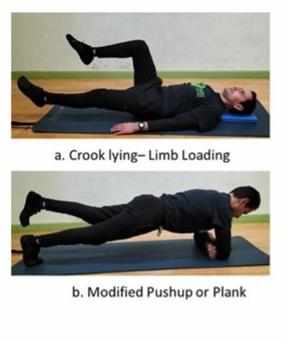
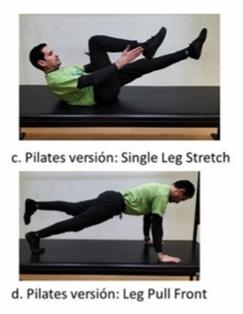
Figure II. Examples of high-load tasks (a, b) according to Mottram and Comerford criteria (2008), and examples of the Pilates version of these exercises (c, d).
Taken from Aragon Salamanca, 2024 under CC BY-NC 4.0
Lederman, this continuous activation of the core muscles can potentially jeopardize the structures of the spine, and “Patients who have been trained to use complex abdominal hollowing and bracing maneuvers should be discouraged from using them” (Lederman, 2010) Already in 2010 Lederman was very clear about it The “TakePilates-Classes” Messageis that the use of ADIM should be discouraged
The foundation base of cueing a voluntary contraction of the abdominal wall for postural stability control seems to go against the fundamentals of Neuroanatomy Neuroanatomy tells us that the neuromotor system has two descending pathways for the motor signals from the brain to the lower motor neurons (Lee and Muzio, 2022) Thesepathways are split in Pyramidal and Extrapyramidal tracts The Pyramidal tracts give motor signals for the conscious control of the muscles of the body. The Extrapyramidal tracts carry motor signals for the unconscious, reflexive, or responsive control of the type I slow-twitch tonic motor fibers, muscle fibers with a dominant postural and control balance roles (Lee and Muzio, 2022) as the TrA fibers.Interference with this natural reaction in healthy people with a conscious activation of specific muscles may impairs the stability strategies of the nervous system If we train these muscles with phasic conscious exercises could lead to a muscle tone dysfunction (Cabañas and Chapinal, 2014). Again, the “TakePilates-Classes” Message is ADIM may interfere with the postural control goals of the Pilates Method
a) Because we want to improve the lumbo-pelvic stability (LPS) As we have seen, the ADIM aim is to get a specific activation of the TrA muscle TrA is considered a local muscle with an essential lumbar postural role through the Intra Abdominal Pressure control but with a limited capacity to control the orientation of the lumbar spine (Richardson et al, 2007) (Bergmark, 1989) Local muscles of the core are essential for the stability of the lumbo-pelvic region but not enough for its orientation control, while Rectus Abdominis (RA), as a muscle part of the global system, is critical for the direction control of the spine and transfer of loads from thorax to pelvis(Bergmark, 1989) The RA muscle has the capacity for pelvic orientation control when the thorax is a fixed point (Neuman, 2010) (Kendall et al, 2007) RA is the most important abdominal muscle in order to correct the lumbar lordosis through the control of the anterior pelvic tilt thanks to its large lever arm (Kapanji, 2017)
The Internal Oblique (IO) is considered another local muscle of the
ISSUE 17 PILATESJOURNAL COM 33 ABDOMINAL WORK
core area, and is associated with the TrA in the maneuver of drawing the abdominal wall in (O’Sullivan, 1998) During a high-load task like a “Plank” and a supine “Double Leg Raise”, the RA activation is higher than that of the IO (Park and Park, 2019). Furthermore, during an unstable “Plank” position, on a TRX, the RA activation (88,3 %MVC) was even higher than for the EO (Topcu et al, 2022), giving an idea of the important input of the RA global muscle during these high-load core stability exercises.The anatomy analysis of the horizontal orientation of the muscle fibers of the TrA and the vertical orientation of RA muscle fibers show a mostly perpendicular relationship between both muscles (Neuman, 2010) (Kapanji, 2017). This perpendicular relationship could put both muscles in a sort of competitive situation because when the TrA contracts, pullingfrom the connective tissues of the RA sheath, it stretches the RA fibers (Lee D and Hodges,2016), compromising its concentric contraction direction (Figure III).
Besides, the EMG analysis of the core muscles showed that ADIM decreases the RA activation and increases that of the TrA (Oshikawa et al, 2020) (Kim and Oh, 2015) (Vera-Garcia et al, 2007): when one decreases the other one increase, which may give us another indication of this competition
During low-load tasks local muscle input is greater than global muscle input (EMG data from Biscarini et al , 2018) During high-load tasks global muscle input is greater than local muscle input (EMG data from Park & Park, 2019) During a Leg Pull Front, a high-load Pilates exercise, the ADIM was less effective at controlling the pelvic rotation [Jung & Oh, 2022], perhaps because the drawing-in maneuver impaired global muscle input, the main source of stability (Figure V) Therefore, the “Take-Pilates-Classes” Message is that excessive activation of the TrA or the IO during the ADIM could compromise the RA input for pelvic anterior tilt control and hyper-lordosis control during high-load tasks such as some of the Pilates exercises.

a) Because we want to keep the traditional way of the Pilates Method
There are several people who argue that if you do not apply the Pilates method in the original way, you are not doing real Pilates
The Pilates Method was made known by several of his early assistants who opened their own studios and developed some new approaches to the original principles (Latey, 2001). Today, there are several Pilates franchises and “schools” who have developed their own list of Principles
In our opinion, the Pilates Method has been evolving from the very beginning and it should integrate all relevant new knowledge and scientific evidence to remain one of the most important exercise techniques in the motor control and postural education field
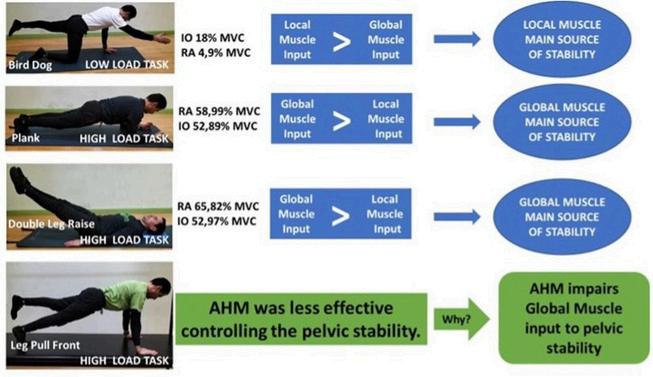
ISSUE 17 PILATESJOURNAL COM 34 ABDOMINAL WORK
Figure III. The concentric contraction of the TrA fibers pull from the RA, stretching its muscle fibers. TrA: Transversus Abdominis. RA: Rectus Abdominis.
Taken from Aragon Salamanca, 2024 under CC BY-NC 4.0
Figure V. IO: Internal Oblique. RA: Rectus Abdominis. MVC: Maximal Voluntary Contraction. AHM: Abdominal Hollowing Maneuver = ADIM.
Taken from Aragon Salamanca, 2024 under CC BY-NC 4.0
In order to provide a new perspective on whether the ADIM should be a rule applied by Pilates practitioners we have reviewed recent literature. Our main conclusions are: Concerning the use of the ADIM to perform a selective activation of the TrA muscle, our opinion is that, although ADIM can increase TrA activation, Pilates exercises do not meet the requirements for isolated TrA-specific retraining. The application of ADIM during Pilates exercises, without quality control of the TrA activation, could impair spinal stabilization strategies Enhanced activation of the TrA during ADIM increases the IRD under DRA conditions and is discouraged in patients with hernia repair or severe uncorrected abdominal hernia The continuous conscious activation of the core muscles can potentially jeopardize the structures of the spine.Neuroanatomy concepts contradict the use of a conscious muscle activation technique, such as ADIM, to enhance the postural tonic role of the TrA muscle
References:
With regard to the use of the ADIM to improve LPS, we conclude that excessive activation of TrA during an ADIM, an essential but ineffective local muscle for pelvic orientation control, may interfere with RA input for pelvic directional control during high-load Pilates exercises. The AHM is less effective at controlling pelvic rotation during two typical Pilates scenarios, an “active supine straight leg raises” and a “front Plank ”
Julio C. Aragón-Salamanca graduated in Physical Activity and Sport Sciences from the University of the Basque Country and holds a Master’s degree in Sport Injury Rehabilitation. A Certified Specialist in the Pilates Method, he has been the owner, technical director, and instructor at Pilates Studio el Patio, a Pilates and rehabilitation center in Madrid, Spain, since 2005.
1.Aragón Salamanca, J. C. (2024). We should not keep drawing-in the abdominal wall during the core training. International Journal of Sport Studies for Health, 7(1), 27-35. https://doi.org/10.61838/kman.intjssh.7.1.4
Bergmark A, 1989. Stability of the lumbar spine A study in mechanical engineering Acta Orthopaedia Scandinavia Suplementum. No. 230, Vol. 60.1989 1
2
3
Biscarini A, Contemori S, Grolla G., 2018. Activation of Scapular and Lumbopelvic Muscles During Core Exercises Executed on Whole-Body Wobble Board. Journal of Sport Rehabilitation. 28(6):1-26.
Cabañas A, Chapinal AA, 2014. Hypopressive abdominal gymnastics: A theoretical analysis and a review. Apunts. Medicina de l'Esport.49(182):59-66.
4 Comerford MJ, 2004. Core stability: Priorities in rehab of the athlete. SportEx Medicine.; 22, 15–22
Caplan N, Gibbon K, Hibbs A, Evetts S, Debuse D, 2014. Phasic-to-tonic shift in trunk muscle activity relative to walking during low-impact weight bearing exercise. Acta Astronautica Volume 104, Issue 1, November;p. 388-395.
5 Comerford MJ, Mottram SL, 2001. Movement and stability dysfunction-contemporary developments. Man Ther. Feb;6(1):15-26.
7
6 Henry SM, Westervelt KC, 2005. The use of real-time ultrasound feedback in teaching abdominal hollowing exercises to healthy subjects. J Orthop Sports Phys Ther ; 35:338–45.
8
Jung E, Oh JS, 2022. The Effects of Abdominal Hollowing and Bracing Maneuvers on Trunk Muscle Activity and Pelvic Rotation Angle during Leg Pull Front Pilates Exercise. Healthcare (Basel). Dec 26;11(1):60.
Kapanji AJ., 2017. Volume 3: Joint Physiology. 6 Edition. Editorial Medica Panamericana.; pag164. ISBN: 978-84-9835-460-7. p. 118-119/p.108-109/p. 164
10
9 Kendall PF, Kendall E, Geise P, McIntyre M, Romani WA., 2007. Kendall`s: Muscles, Testing and Function, with Posture and Pain. Marban, S.L.; ISBN: 84-7101-527-7. p. 194
11
Kim MH, Oh JS., 2015. Effects of performing an abdominal hollowing exercise on trunk muscle activity during curl-up exercise on an unstable surface. J. Phys. Ther. Sci.; 27: 501–503.
Latey P., 2001. The Pilates method: history and philosophy. J. Bodyw. Mov. Ther.; 5(4), 275-282.
14
12 Lederman E, 2010. The myth of core stability. J. Bodyw. Mov. Ther.; 14, 84-98. 13 Lee D, Hodges PW, 2016. Behavior of the Linea Alba During a Curl-up Task in Diastasis Rectus Abdominis: An Observational StudyJOrthop Sports Phys Ther. Jul;46(7):580-9.
19
Lee J, Muzio MR, 2022. Neuroanatomy, Extrapyramidal System. StatPearls Publishing. PMID: 32119429 Bookshelf ID: NBK554542 15 Lynders C, 2019. The Critical Role of Development of the Transversus Abdominis in the Prevention and Treatment of Low-back pain. HSS J. Oct;15(3):214-220. 16 Merrithew Corporation, 2001. Comprehensive Matwork Manual, Stott Pilates. Merrithew Publishing.; 2220 Yonge Street, Toronto, ON, Cabada M4S 2C6. p. 4-5. 17 Mottram S and Comerford M, 2008. A new perspective on risk assessment. Physical Therapy in Sport.; 9, 40-51. 18 Neuman D. A., 2010. Kinesiology of the musculoskeletal system. Foundation for rehabilitation. 2nd Edition. EVOLVE MOSBY ELSEVIER. ISBN: 978-0-323-03989-5. p. 340/p.390/p.395
20 Oshikawa T, Adachi G, Akuzawa H, Okubo Y, and Koji Kaneoka K, 2020. Electromyographic analysis of abdominal muscles during abdominal bracing and hollowing among six different positions. J Phys Fitness Sports Med,; 9 (4): 157-163.
O’Sullivan PB, Twomey L, Allison GT., 1998. Altered abdominal muscle recruitment in patients with chronic back pain following a specific exercise intervention. J Orthopedic Sports Phys Ther.;27(2):114–24
21 Park D-J, Park S-W, 2019. Which trunk exercise most effectively activates abdominal muscles? A comparative study of plank and isometric bilateral leg raise exercises. J Back MusculoskeletRehabil. 32(5):797-802.
23
22 Pascoal AG, Dionisio S, Cordeiro F, Mota P, 2014. Inter-rectus distance in postpartum women can be reduced by isometric contraction of the abdominal muscles: a preliminary case-control study. Physiotherapy. Dec;100(4):344-8.
25
24 Richardson CA, Jull GA, Toppenberg R, Comerford M, 1992. Techniques for active lumbar stabilization for spinal protection: a pilot study. Aust J Physiother.;138(2):105–112.
Richardson C, Hodges P, Hides J, 2007. Therapeutic Exercise for Lumbopelvic Stabilization. 2nd Edition. Churchill Livingstone.. ISBN: 0 443 07293 0. p. 185219/p.55/p.50/p. 5,105-117/p.5,173/p.13-28/p.41.
26
27
Teyhen SD, Miltenberger EC, Deiters HM, et al, 2005. The use of ultrasound imaging of the abdominal drawing-in maneuver in subjects with low-back pain. J Orthop Sports Phys Ther. Jun; 35(6):346-55.
Theodorsen N-H, Strand LI, Bo K, 2019. Effect of pelvic floor and transversus abdominis muscle contraction on inter-rectus distance in postpartum women: a cross-sectional experimental study. Physiotherapy 105; 315–320.
29
28 Van Dieen, JH, Cholewicki, J, Radebold, A, 2003. Trunk muscle recruitment patterns in patients with low back pain enhance the stability of the lumbar spine. Spine; 28 (8), 834e841.
Topcu H, Arabaci R, Gungor AK,Birinci ZY, Pancar S, Sekir U., 2022. Muscle Activity of Core Muscles During Plank Exercise on Different Surfaces. Turkish Journal of Sport and Exercise.; Volume 24, Issue 3, 298 - 305, 31.12.2022
Vera-Garcia FJ, Elvira JLL, Brown SHM, McGill SM, 2007. Effects of abdominal stabilization maneuvers on the control of spine motion and stability against sudden trunk perturbations. J ElectromyogrKinesiol. Oct;17(5):556-67. 30
ISSUE 17 PILATESJOURNAL COM 35 ABDOMINAL WORK
3. Conclusions
Instructor Spotlight: Andrea Jobbagy
WE SPEAK WITH PILATES INSTRUCTOR ANDREA JOBBAGY ABOUT HER PILATES CAREER AND HER TEACHING FOCUS
Tell us a little about yourself and your Pilates background?
I'm Andrea I currently live in Hungary which is where I was born I moved to the UK at the age of 18 after I finished my A-levels also known as the European Baccalaureate I spent 20 years in the UK during which I pursued higher education and established a thriving Pilates studio in Oxford called Oxford Pilates.
How did you discover Pilates?
I discovered Pilates while pursuing my Sports Therapy diploma at Thames Valley University Reading College My tutor, a Pilates enthusiast herself, encouraged me to enrol in a Pilates course to enhance my skillset as a sports therapist.
How do you keep learning? What inspires you in your work?
I am a curious person in general I love learning, I go to workshops and conferences regularly, and I enjoy listening to podcasts But the best teachers are my clients - nothing can replace the experience that you gain while teaching and meeting different people with different needs and personalities

The best Pilates course you ever did was
I trained with Polestar Pilates UK and I think they are great I have also done workshops with Eric Franklin which is not technically Pilates but his courses in my opinion give lots of practical tools for any movement professional
What’s your favourite piece of equipment to use with clients in studio and why?
The best advice you were ever given as a teacher...
Learn the art of pausing and embracing the concept of 'less is more' This is particularly important between cues as we need to allow clients time to process initial instructions, absorb cues and feel their impact before introducing the next instruction
This really depends on what I am trying to achieve. I use all the equipment and often use a variety of equipment within the one session However, I am also very happy to teach just a mat class with no equipment at all The focus is always on the 'body' and what the individual needs rather than the latest equipment I may have at my studio Q. A.
I work out, go to classes, network with other instructors, see my clients progress, mentor new instructors whose enthusiasm is infectious, set goals for myself and continuously evolve How do you stay motivated?
Is there something you try and instil in each of your clients?
Everyone is different so I don't think there is one particular thing I would emphasise with every client other than teach them how to listen to their own body
Q.
A.
What makes you laugh the most?
I like clever wordplay or witty observations My brother is a master of that. He can just say one word at a family table and everyone bursts out laughing
ISSUE 17 PILATESJOURNAL COM 36
Q. A.
Q. A.
Q. A.
INSTRUCTOR SPOTLIGHT
Q. A. Q. A.
Q. A.
Q. A.
What's your favourite way to spend a day off?
With friends
How many pairs of grip socks do you own? Do you love or hate a stretch band?
I admit I don’t have that many pairs of for a Pilates instructor...maybe 5. There are many different types of stretch bands but I generally like them because they are lightweight and don't take up space This means you can even take them on holiday and have a full-body resistance workout while you are on the go.
Does your family ‘really know’ what’s involved in your job
No They don't My dad describes Pilates as ‘stretching and gymnastics’ I think my mum understands more what Pilates is as a method, but I am also self-employed, run my own business, workshops and am currently working on a teacher training program there is a lot involved in being a Pilates instructor It is not just about ‘teaching some choreographed moves’.
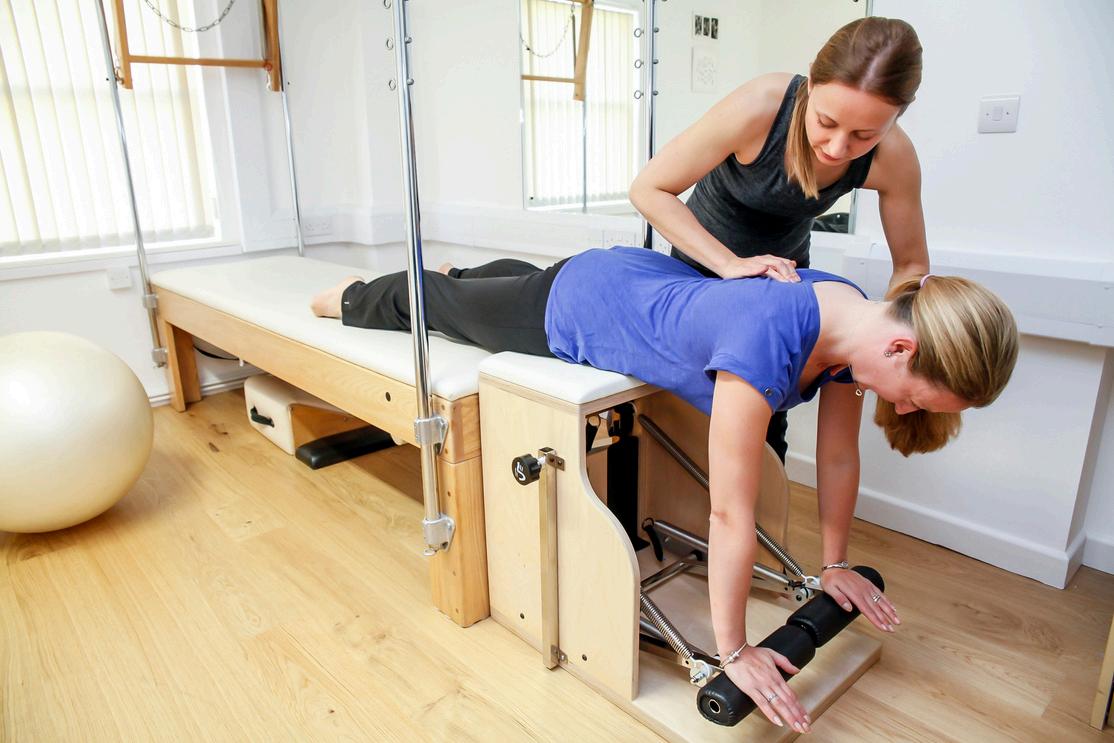
Andrea owns Oxford Pilates in the UK. You find her studio here

ISSUE 17 PILATESJOURNAL COM INSTRUCTOR SPOTLIGHT
Q. A.
Q. A.
Q.
A.
Upcoming courses
BASIAUSTRALIA
Comprehensive Teacher Training Course – Brisbane – BASI Pilates Academy Aust – 16 Aug – 17 Nov Mat and Reformer Mat program
Comprehensive Teacher Training Course – Perth – Rig Pilates – 13 Sept-8 Dec Mat and Reformer Mat program
Find out more basipilates com au/education/
BODYORGANICSEDUCATION
Springing this joint - Canberra 22-23 June Melbourne TBC Sydney - Aug/Sept
A full event calendar can be found here
The Pilates Vibe are now running Body Organics Mat, Reformer and Comprehensive Courses in Melbourne
Find out more www bodyorganicseducation com or contact info@bodyorganicseducation com
REACHMOVEMENTHEALTH
Further your education with one of Reach's online masterclass sessions
Join Sally Anderson between Feb-Nov 2024 on the first Saturday of each month for a live online Reformer and Matwork class followed by Q&A Courses also available in Pilates for Pregnancy, Visceral Mobilisation, LumboPelvic Rhythm with Lisa Jackson and or Pilates for Multi-Dimensional Posture and more
Find out more reachmovementhealth com/continuing-education-programs-2023/
PILATESITC
(10838NAT) Diploma of Pilates Instruction, Matwork and Reformer + Small Apparatus Pathway, Reformer and Small Apparatus Pathway, Matwork and Small Apparatus Pathway, Studio Instruction Pathway, Anatomy + Physiology (Online only), (10839NAT) Advanced Diploma of the Pilates Method
Upcoming Blended Entry Points:
NSW: Enrol for Reformer in July
QLD: Enrol for Matwork in June
TAS: Enrol for Matwork in September
All States: Advanced Diploma – enrol and start any time
Continuing Education: Scolio-Pilates® Modules 1 & 2 of the ScolioPilates Professional Certification Program in Perth, Brisbane and Sydney in 2024
Give the Pilates ITC Careers Team a call on (08) 9330 4570 to secure your place - pilatesitc edu au/
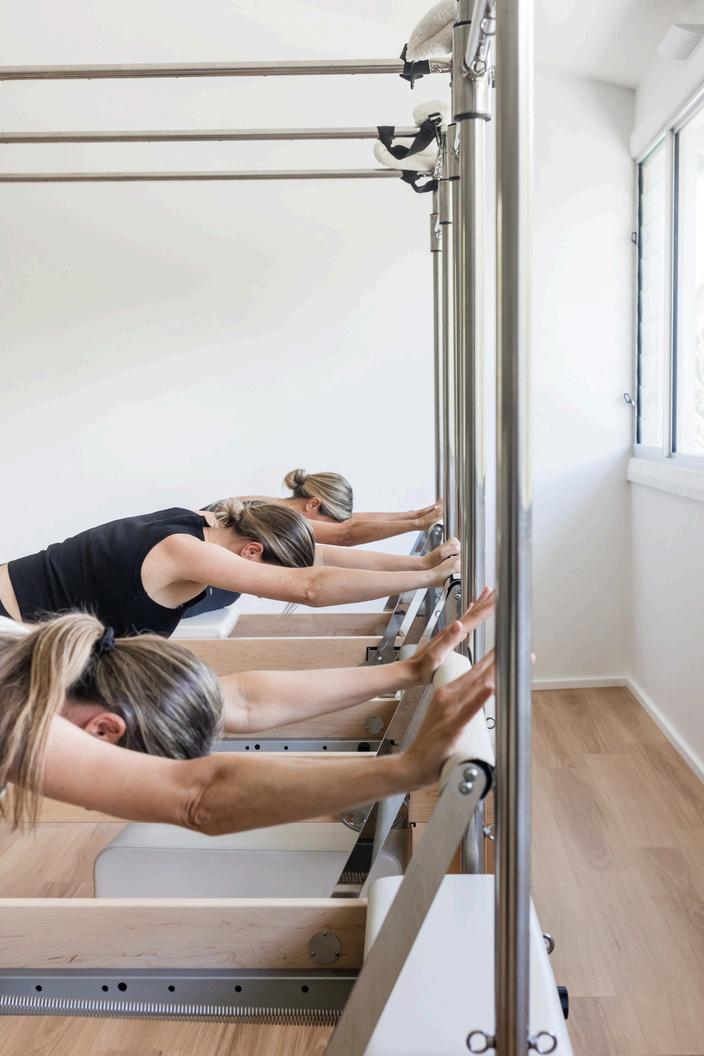
POLESTARPILATES
Upcoming Continuing Education Courses include:
@estroni.official
Polestar Pilates Australia (RTO 91620) offers the government accredited (10828NAT) Diploma of Polestar Pilates Comprehensive Instruction Method
The following pathways are available face-to-face throughout Australia and enrolling now:
Complete Matwork Series: Sydney, Melbourne, Adelaide, Perth, Brisbane, Online (Global)
Comprehensive Studio/Rehab Series: Sydney, Melbourne, Adelaide, Perth, Lismore/ByronBay, Canberra, Hobart/Launceston, Noosa, Darwin
Ultimate Reformer: Sydney, Melbourne, Adelaide, Perth, Noosa, Lismore Anatomy: Online (anytime)
For a complete list of courses see the Polestar website: https://www polestarpilates edu au/courses-ps/
Upcoming Continuing Education Courses include
Online Masterclass series - available anytime
Womens Health 2 days – NSW Sydney 29-30 June, SA Adelaide 27-28 July
Wundarful Chair WS Part 1 – NSW Sydney 01 June
Wundarful Chair WS Part 2 – NSW Sydney 06 July
Mat Masterclass – NT Darwin 20 June
For a complete list of courses see the Polestar website: polestarpilates edu au/pilates-continuing-education/
38
TRAINING COURSES
ISSUE 17 PILATESJOURNAL COM
Upcoming courses
NATIONALPILATESTRAINING
National Pilates Training (21719) offers the following governmentaccredited skill sets and qualifications
Groupfit professional pilates Instruction
Professional pilates matwork Instruction
Professional pilates reformer instruction
Diploma of professional pilates instruction (10838NAT)
Advanced Diploma of the pilates method (10839NAT)
Our government-accredited courses are available in person - Melbourne, Sydney, Brisbane, Canberra, Hervey Bay, Morisset- NSW, Ballarat- Victoria, online only – global
2024 intakes include:
- Melbourne June
- Canberra, June
- Sydney - June
- and more dates on the website
National Pilates Training has courses starting each month, in person, in a location near you and all courses are available online wherever you are Find out more www nationalpilates com au/
STOTTPILATES
STOTT PILATES® Intensive Matwork and Intensive Reformer Courses to be held in 2024 at Innaessence studio in Queensland, Australia
Intensive Cadillac Course – 21-25 Aug 2024
Intensive Chair Course – 28-30 Aug 2024
Intensive Barrel Course - 31 - 1 Sept 2024
Pre-natal Reformer and Post natal Pilates workshops - 26 Aug 2024
Contact Innaessence here
STUDIOPILATES
Studio Pilates offers a number of different courses including:
Matwork Course, Reformer Course, Matwork Programming and Progressions, Platinum Instructing Course, Anatomy Course, Wunda Chair Course, Ball, Circle and Band Course and more
Those in the USA and UK can join one of their online courses via zoom
For a complete list of dates in other states see the Studio Pilates website studiopilates com/education/book-a-course/
TENSEGRITYTRAINING
Cert IV in Contemporary Pilates and Teaching Methodology
Cert IV of Contemporary Pilates and Teaching Methodology (52855WA) with Reformer (Cert IV and Reformer)
Integrated Diploma of Contemporary Pilates and Teaching Methodology Pilates Group Reformer Instructor Training (PGR)
Tensegrity offers training in NSW, QLD, VIC, SA and TAS
For a full list of dates in all states visit tensegritytraining com au/accredited-training/

STOTTPILATES Training at Inna Essence

Attention all STOTT Pilates Trained Teachers: This is your chance to upskill and add to your teaching repertoire
Join our Intensive Cadillac, Chair & Barrels Course (ICCB) in August
Attend one or all 3 courses to enhance your knowledge and teaching capabilities
Intensive Cadillac – 21 - 25 August
Intensive Chair – 28 – 30 August
Intensive Barrels 31 August – 1 September
See all of the other Courses & Workshops offered at Inna Essenceinnaessence com/instructor-training
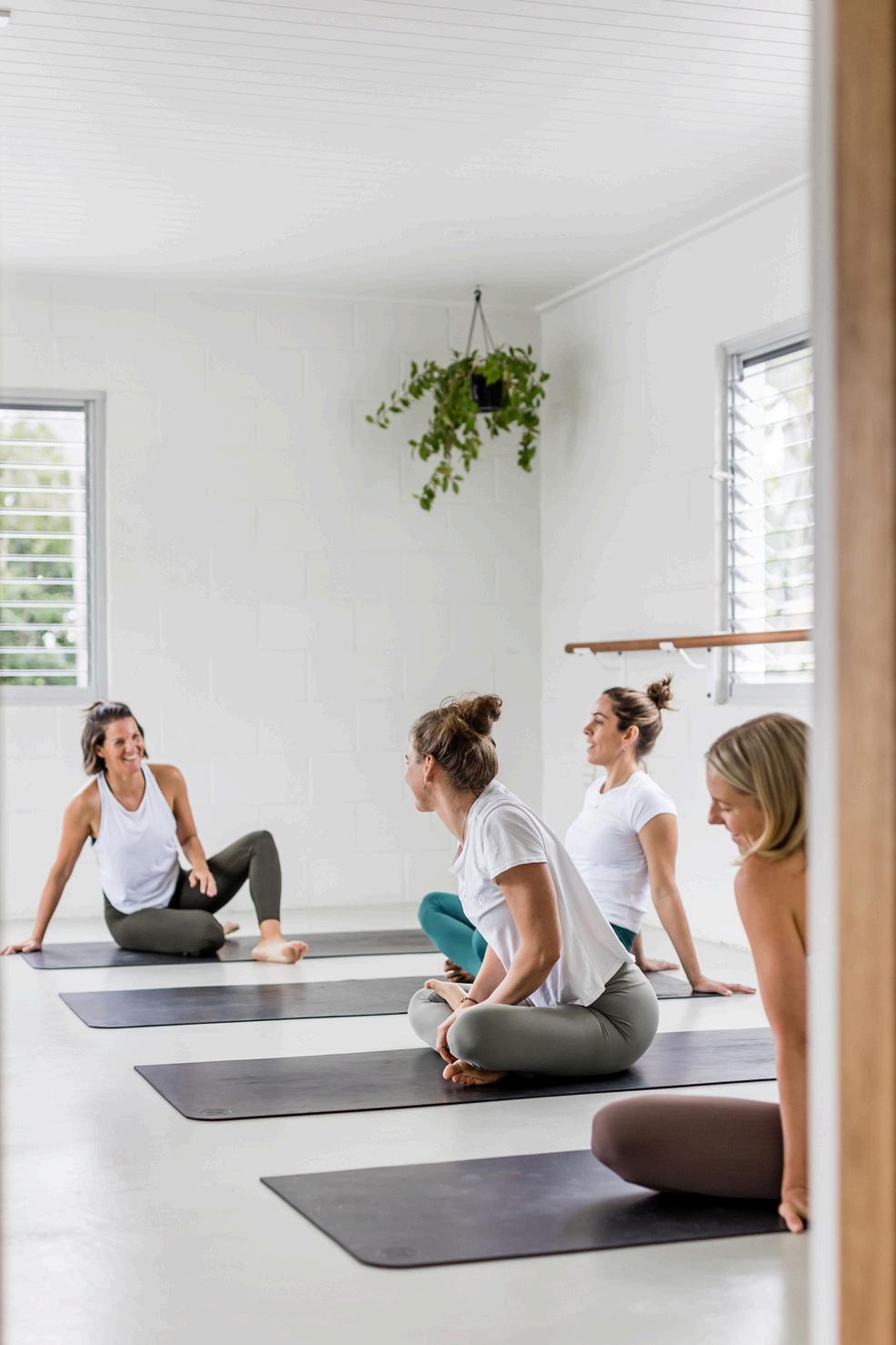
39
ISSUE 17 PILATESJOURNAL COM TRAINING COURSES

Feature your product or business here. Contact us for more information. WWW.PILATESJOURNAL.COM
I S S U E 1 7J U N E 2 0 2 4 A JOURNAL WHERE PILATES PROFESSIONALS COME TOGETHER TO LEARN, DISCOVER AND SHARE IN THE JOY OF MOVEMENT HELLO@PILATESJOURNAL COM PILATESJOURNAL COM











































































